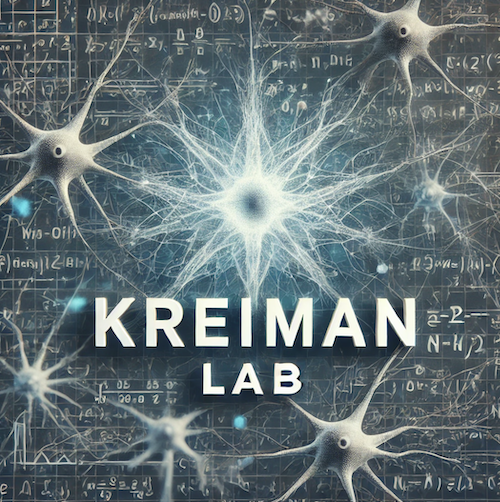6543092
thesis5
1
apa
50
date
211
https://kreimanlab.com/wp-content/plugins/zotpress/
%7B%22status%22%3A%22success%22%2C%22updateneeded%22%3Afalse%2C%22instance%22%3Afalse%2C%22meta%22%3A%7B%22request_last%22%3A0%2C%22request_next%22%3A0%2C%22used_cache%22%3Atrue%7D%2C%22data%22%3A%5B%7B%22key%22%3A%22XRDRCSZS%22%2C%22library%22%3A%7B%22id%22%3A6543092%7D%2C%22meta%22%3A%7B%22creatorSummary%22%3A%22Bricken%22%2C%22parsedDate%22%3A%222025-03-31%22%2C%22numChildren%22%3A0%7D%2C%22bib%22%3A%22%3Cdiv%20class%3D%5C%22csl-bib-body%5C%22%20style%3D%5C%22line-height%3A%202%3B%20padding-left%3A%201em%3B%20text-indent%3A-1em%3B%5C%22%3E%5Cn%20%20%3Cdiv%20class%3D%5C%22csl-entry%5C%22%3EBricken%2C%20T.%20%282025%29.%20%3Ci%3ESparse%20representations%20in%20artificial%20and%20biological%20neural%20networks%3C%5C%2Fi%3E%20%5BHarvard%20University%5D.%20%3Ca%20class%3D%27zp-ItemURL%27%20href%3D%27https%3A%5C%2F%5C%2Fdrive.google.com%5C%2Ffile%5C%2Fd%5C%2F1HaJ2uM5GhsPaEe9YnCkRGvYb9I192DII%5C%2Fview%3Fusp%3Dsharing%27%3Ehttps%3A%5C%2F%5C%2Fdrive.google.com%5C%2Ffile%5C%2Fd%5C%2F1HaJ2uM5GhsPaEe9YnCkRGvYb9I192DII%5C%2Fview%3Fusp%3Dsharing%3C%5C%2Fa%3E%3C%5C%2Fdiv%3E%5Cn%3C%5C%2Fdiv%3E%22%2C%22data%22%3A%7B%22itemType%22%3A%22thesis%22%2C%22title%22%3A%22Sparse%20representations%20in%20artificial%20and%20biological%20neural%20networks%22%2C%22creators%22%3A%5B%7B%22creatorType%22%3A%22author%22%2C%22firstName%22%3A%22Trenton%22%2C%22lastName%22%3A%22Bricken%22%7D%5D%2C%22abstractNote%22%3A%22%22%2C%22thesisType%22%3A%22%22%2C%22university%22%3A%22Harvard%20University%22%2C%22date%22%3A%222025-03-31%22%2C%22language%22%3A%22%22%2C%22url%22%3A%22https%3A%5C%2F%5C%2Fdrive.google.com%5C%2Ffile%5C%2Fd%5C%2F1HaJ2uM5GhsPaEe9YnCkRGvYb9I192DII%5C%2Fview%3Fusp%3Dsharing%22%2C%22collections%22%3A%5B%5D%2C%22dateModified%22%3A%222025-04-01T00%3A55%3A38Z%22%7D%7D%2C%7B%22key%22%3A%22E92TESG9%22%2C%22library%22%3A%7B%22id%22%3A6543092%7D%2C%22meta%22%3A%7B%22creatorSummary%22%3A%22Krishnan%22%2C%22parsedDate%22%3A%222025%22%2C%22numChildren%22%3A0%7D%2C%22bib%22%3A%22%3Cdiv%20class%3D%5C%22csl-bib-body%5C%22%20style%3D%5C%22line-height%3A%202%3B%20padding-left%3A%201em%3B%20text-indent%3A-1em%3B%5C%22%3E%5Cn%20%20%3Cdiv%20class%3D%5C%22csl-entry%5C%22%3EKrishnan%2C%20S.%20%282025%29.%20%3Ci%3EBeyond%20modalities%3A%20robust%20neural%20representation%20of%20language%20in%20the%20brain%3C%5C%2Fi%3E%20%5BBirla%20Insittute%20of%20Technology%20and%20Science%5D.%20%3Ca%20class%3D%27zp-ItemURL%27%20href%3D%27https%3A%5C%2F%5C%2Fdrive.google.com%5C%2Ffile%5C%2Fd%5C%2F1yE57J72RdtM65XR0kJvKUvJifwQliGDm%5C%2Fview%3Fusp%3Dsharing%27%3Ehttps%3A%5C%2F%5C%2Fdrive.google.com%5C%2Ffile%5C%2Fd%5C%2F1yE57J72RdtM65XR0kJvKUvJifwQliGDm%5C%2Fview%3Fusp%3Dsharing%3C%5C%2Fa%3E%3C%5C%2Fdiv%3E%5Cn%3C%5C%2Fdiv%3E%22%2C%22data%22%3A%7B%22itemType%22%3A%22thesis%22%2C%22title%22%3A%22Beyond%20modalities%3A%20robust%20neural%20representation%20of%20language%20in%20the%20brain%22%2C%22creators%22%3A%5B%7B%22creatorType%22%3A%22author%22%2C%22firstName%22%3A%22Shreyas%22%2C%22lastName%22%3A%22Krishnan%22%7D%5D%2C%22abstractNote%22%3A%22%22%2C%22thesisType%22%3A%22%22%2C%22university%22%3A%22Birla%20Insittute%20of%20Technology%20and%20Science%22%2C%22date%22%3A%222025%22%2C%22language%22%3A%22%22%2C%22url%22%3A%22https%3A%5C%2F%5C%2Fdrive.google.com%5C%2Ffile%5C%2Fd%5C%2F1yE57J72RdtM65XR0kJvKUvJifwQliGDm%5C%2Fview%3Fusp%3Dsharing%22%2C%22collections%22%3A%5B%5D%2C%22dateModified%22%3A%222025-03-26T04%3A02%3A05Z%22%7D%7D%2C%7B%22key%22%3A%22RHQG8TM4%22%2C%22library%22%3A%7B%22id%22%3A6543092%7D%2C%22meta%22%3A%7B%22creatorSummary%22%3A%22Otani%22%2C%22parsedDate%22%3A%222025%22%2C%22numChildren%22%3A0%7D%2C%22bib%22%3A%22%3Cdiv%20class%3D%5C%22csl-bib-body%5C%22%20style%3D%5C%22line-height%3A%202%3B%20padding-left%3A%201em%3B%20text-indent%3A-1em%3B%5C%22%3E%5Cn%20%20%3Cdiv%20class%3D%5C%22csl-entry%5C%22%3EOtani%2C%20A.%20%282025%29.%20%3Ci%3EMitigating%20catastrophic%20forgetting%20and%20mode%20collapse%20in%20text-to-image%20diffusion%20via%20latent%20replay%3C%5C%2Fi%3E%20%5BHarvard%20University%5D.%20%3Ca%20class%3D%27zp-ItemURL%27%20href%3D%27https%3A%5C%2F%5C%2Fdrive.google.com%5C%2Ffile%5C%2Fd%5C%2F1rLujxuEh22Vchd6NmQ8ulWf0CXuP7LGy%5C%2Fview%3Fusp%3Dsharing%27%3Ehttps%3A%5C%2F%5C%2Fdrive.google.com%5C%2Ffile%5C%2Fd%5C%2F1rLujxuEh22Vchd6NmQ8ulWf0CXuP7LGy%5C%2Fview%3Fusp%3Dsharing%3C%5C%2Fa%3E%3C%5C%2Fdiv%3E%5Cn%3C%5C%2Fdiv%3E%22%2C%22data%22%3A%7B%22itemType%22%3A%22thesis%22%2C%22title%22%3A%22Mitigating%20catastrophic%20forgetting%20and%20mode%20collapse%20in%20text-to-image%20diffusion%20via%20latent%20replay%22%2C%22creators%22%3A%5B%7B%22creatorType%22%3A%22author%22%2C%22firstName%22%3A%22Aoi%22%2C%22lastName%22%3A%22Otani%22%7D%5D%2C%22abstractNote%22%3A%22%22%2C%22thesisType%22%3A%22%22%2C%22university%22%3A%22Harvard%20University%22%2C%22date%22%3A%222025%22%2C%22language%22%3A%22%22%2C%22url%22%3A%22https%3A%5C%2F%5C%2Fdrive.google.com%5C%2Ffile%5C%2Fd%5C%2F1rLujxuEh22Vchd6NmQ8ulWf0CXuP7LGy%5C%2Fview%3Fusp%3Dsharing%22%2C%22collections%22%3A%5B%5D%2C%22dateModified%22%3A%222025-03-26T04%3A01%3A30Z%22%7D%7D%2C%7B%22key%22%3A%22E5UQGS69%22%2C%22library%22%3A%7B%22id%22%3A6543092%7D%2C%22meta%22%3A%7B%22creatorSummary%22%3A%22Madan%22%2C%22parsedDate%22%3A%222024%22%2C%22numChildren%22%3A0%7D%2C%22bib%22%3A%22%3Cdiv%20class%3D%5C%22csl-bib-body%5C%22%20style%3D%5C%22line-height%3A%202%3B%20padding-left%3A%201em%3B%20text-indent%3A-1em%3B%5C%22%3E%5Cn%20%20%3Cdiv%20class%3D%5C%22csl-entry%5C%22%3EMadan%2C%20S.%20%282024%29.%20%3Ci%3EOut-of-distribution%20generalization%20in%20biological%20and%20artificial%20intelligence%3C%5C%2Fi%3E%20%5BHarvard%20University%5D.%20%3Ca%20class%3D%27zp-ItemURL%27%20href%3D%27https%3A%5C%2F%5C%2Fdrive.google.com%5C%2Ffile%5C%2Fd%5C%2F19_azuONFThFBpG4yxAr5KB_e0WBKUeug%5C%2Fview%3Fusp%3Dsharing%27%3Ehttps%3A%5C%2F%5C%2Fdrive.google.com%5C%2Ffile%5C%2Fd%5C%2F19_azuONFThFBpG4yxAr5KB_e0WBKUeug%5C%2Fview%3Fusp%3Dsharing%3C%5C%2Fa%3E%3C%5C%2Fdiv%3E%5Cn%3C%5C%2Fdiv%3E%22%2C%22data%22%3A%7B%22itemType%22%3A%22thesis%22%2C%22title%22%3A%22Out-of-distribution%20generalization%20in%20biological%20and%20artificial%20intelligence%22%2C%22creators%22%3A%5B%7B%22creatorType%22%3A%22author%22%2C%22firstName%22%3A%22Spandan%22%2C%22lastName%22%3A%22Madan%22%7D%5D%2C%22abstractNote%22%3A%22%22%2C%22thesisType%22%3A%22%22%2C%22university%22%3A%22Harvard%20University%22%2C%22date%22%3A%222024%22%2C%22language%22%3A%22%22%2C%22url%22%3A%22https%3A%5C%2F%5C%2Fdrive.google.com%5C%2Ffile%5C%2Fd%5C%2F19_azuONFThFBpG4yxAr5KB_e0WBKUeug%5C%2Fview%3Fusp%3Dsharing%22%2C%22collections%22%3A%5B%22IPHBZG6K%22%5D%2C%22dateModified%22%3A%222024-10-10T22%3A21%3A41Z%22%7D%7D%2C%7B%22key%22%3A%2265IHQUHW%22%2C%22library%22%3A%7B%22id%22%3A6543092%7D%2C%22meta%22%3A%7B%22creatorSummary%22%3A%22Bechard%22%2C%22parsedDate%22%3A%222024%22%2C%22numChildren%22%3A0%7D%2C%22bib%22%3A%22%3Cdiv%20class%3D%5C%22csl-bib-body%5C%22%20style%3D%5C%22line-height%3A%202%3B%20padding-left%3A%201em%3B%20text-indent%3A-1em%3B%5C%22%3E%5Cn%20%20%3Cdiv%20class%3D%5C%22csl-entry%5C%22%3EBechard%2C%20D.%20%282024%29.%20%3Ci%3EThe%20pen%20and%20the%20processor%3A%20A%20Turing-like%20test%20to%20gauge%20GPT-generated%20poetry%3C%5C%2Fi%3E%20%5BThesis%2C%20Harvard%20University%5D.%20%3Ca%20class%3D%27zp-ItemURL%27%20href%3D%27https%3A%5C%2F%5C%2Fdrive.google.com%5C%2Ffile%5C%2Fd%5C%2F18sq6VxwcYBVrMjMZB8UwgcGWD5D26zKD%5C%2Fview%3Fusp%3Dsharing%27%3Ehttps%3A%5C%2F%5C%2Fdrive.google.com%5C%2Ffile%5C%2Fd%5C%2F18sq6VxwcYBVrMjMZB8UwgcGWD5D26zKD%5C%2Fview%3Fusp%3Dsharing%3C%5C%2Fa%3E%3C%5C%2Fdiv%3E%5Cn%3C%5C%2Fdiv%3E%22%2C%22data%22%3A%7B%22itemType%22%3A%22thesis%22%2C%22title%22%3A%22The%20pen%20and%20the%20processor%3A%20A%20Turing-like%20test%20to%20gauge%20GPT-generated%20poetry%22%2C%22creators%22%3A%5B%7B%22creatorType%22%3A%22author%22%2C%22firstName%22%3A%22Deni%22%2C%22lastName%22%3A%22Bechard%22%7D%5D%2C%22abstractNote%22%3A%22%22%2C%22thesisType%22%3A%22Thesis%22%2C%22university%22%3A%22Harvard%20University%22%2C%22date%22%3A%222024%22%2C%22language%22%3A%22%22%2C%22url%22%3A%22https%3A%5C%2F%5C%2Fdrive.google.com%5C%2Ffile%5C%2Fd%5C%2F18sq6VxwcYBVrMjMZB8UwgcGWD5D26zKD%5C%2Fview%3Fusp%3Dsharing%22%2C%22collections%22%3A%5B%5D%2C%22dateModified%22%3A%222024-10-10T22%3A05%3A53Z%22%7D%7D%2C%7B%22key%22%3A%22DWIFXPM4%22%2C%22library%22%3A%7B%22id%22%3A6543092%7D%2C%22meta%22%3A%7B%22creatorSummary%22%3A%22Alvandian%22%2C%22parsedDate%22%3A%222024%22%2C%22numChildren%22%3A0%7D%2C%22bib%22%3A%22%3Cdiv%20class%3D%5C%22csl-bib-body%5C%22%20style%3D%5C%22line-height%3A%202%3B%20padding-left%3A%201em%3B%20text-indent%3A-1em%3B%5C%22%3E%5Cn%20%20%3Cdiv%20class%3D%5C%22csl-entry%5C%22%3EAlvandian%2C%20N.%20%282024%29.%20%3Ci%3ETesting%20the%20alignment%20of%20multimodal%20neural%20networks%20models%20to%20human%20brain%20areas%3C%5C%2Fi%3E%20%5BThesis%2C%20EPFL%5D.%20%3Ca%20class%3D%27zp-ItemURL%27%20href%3D%27https%3A%5C%2F%5C%2Fdrive.google.com%5C%2Ffile%5C%2Fd%5C%2F1IwBY0-ba90GnC36EYBhCnmkFHIqSCVSY%5C%2Fview%3Fusp%3Dsharing%27%3Ehttps%3A%5C%2F%5C%2Fdrive.google.com%5C%2Ffile%5C%2Fd%5C%2F1IwBY0-ba90GnC36EYBhCnmkFHIqSCVSY%5C%2Fview%3Fusp%3Dsharing%3C%5C%2Fa%3E%3C%5C%2Fdiv%3E%5Cn%3C%5C%2Fdiv%3E%22%2C%22data%22%3A%7B%22itemType%22%3A%22thesis%22%2C%22title%22%3A%22Testing%20the%20alignment%20of%20multimodal%20neural%20networks%20models%20to%20human%20brain%20areas%22%2C%22creators%22%3A%5B%7B%22creatorType%22%3A%22author%22%2C%22firstName%22%3A%22Narek%22%2C%22lastName%22%3A%22Alvandian%22%7D%5D%2C%22abstractNote%22%3A%22%22%2C%22thesisType%22%3A%22Thesis%22%2C%22university%22%3A%22EPFL%22%2C%22date%22%3A%222024%22%2C%22language%22%3A%22%22%2C%22url%22%3A%22https%3A%5C%2F%5C%2Fdrive.google.com%5C%2Ffile%5C%2Fd%5C%2F1IwBY0-ba90GnC36EYBhCnmkFHIqSCVSY%5C%2Fview%3Fusp%3Dsharing%22%2C%22collections%22%3A%5B%5D%2C%22dateModified%22%3A%222024-08-26T18%3A04%3A40Z%22%7D%7D%2C%7B%22key%22%3A%224VEUC3RI%22%2C%22library%22%3A%7B%22id%22%3A6543092%7D%2C%22meta%22%3A%7B%22creatorSummary%22%3A%22Kaminsky%22%2C%22parsedDate%22%3A%222024%22%2C%22numChildren%22%3A0%7D%2C%22bib%22%3A%22%3Cdiv%20class%3D%5C%22csl-bib-body%5C%22%20style%3D%5C%22line-height%3A%202%3B%20padding-left%3A%201em%3B%20text-indent%3A-1em%3B%5C%22%3E%5Cn%20%20%3Cdiv%20class%3D%5C%22csl-entry%5C%22%3EKaminsky%2C%20T.%20%282024%29.%20%3Ci%3ETowards%20characterizing%20curriculum%20reinforcement%20learning%20in%20sparse%20robotics%20tasks%3C%5C%2Fi%3E%20%5BThesis%2C%20Harvard%20University%5D.%20%3Ca%20class%3D%27zp-ItemURL%27%20href%3D%27https%3A%5C%2F%5C%2Fdrive.google.com%5C%2Ffile%5C%2Fd%5C%2F1HwuioL2OVAe7Gh1RZS7Rf4SfFOZQFi_9%5C%2Fview%3Fusp%3Dsharing%27%3Ehttps%3A%5C%2F%5C%2Fdrive.google.com%5C%2Ffile%5C%2Fd%5C%2F1HwuioL2OVAe7Gh1RZS7Rf4SfFOZQFi_9%5C%2Fview%3Fusp%3Dsharing%3C%5C%2Fa%3E%3C%5C%2Fdiv%3E%5Cn%3C%5C%2Fdiv%3E%22%2C%22data%22%3A%7B%22itemType%22%3A%22thesis%22%2C%22title%22%3A%22Towards%20characterizing%20curriculum%20reinforcement%20learning%20in%20sparse%20robotics%20tasks%22%2C%22creators%22%3A%5B%7B%22creatorType%22%3A%22author%22%2C%22firstName%22%3A%22Thomas%22%2C%22lastName%22%3A%22Kaminsky%22%7D%5D%2C%22abstractNote%22%3A%22%22%2C%22thesisType%22%3A%22Thesis%22%2C%22university%22%3A%22Harvard%20University%22%2C%22date%22%3A%222024%22%2C%22language%22%3A%22%22%2C%22url%22%3A%22https%3A%5C%2F%5C%2Fdrive.google.com%5C%2Ffile%5C%2Fd%5C%2F1HwuioL2OVAe7Gh1RZS7Rf4SfFOZQFi_9%5C%2Fview%3Fusp%3Dsharing%22%2C%22collections%22%3A%5B%22IPHBZG6K%22%5D%2C%22dateModified%22%3A%222024-07-29T00%3A56%3A00Z%22%7D%7D%2C%7B%22key%22%3A%22GS9IFPSN%22%2C%22library%22%3A%7B%22id%22%3A6543092%7D%2C%22meta%22%3A%7B%22creatorSummary%22%3A%22Narayanan%22%2C%22parsedDate%22%3A%222024%22%2C%22numChildren%22%3A0%7D%2C%22bib%22%3A%22%3Cdiv%20class%3D%5C%22csl-bib-body%5C%22%20style%3D%5C%22line-height%3A%202%3B%20padding-left%3A%201em%3B%20text-indent%3A-1em%3B%5C%22%3E%5Cn%20%20%3Cdiv%20class%3D%5C%22csl-entry%5C%22%3ENarayanan%2C%20H.%20%282024%29.%20%3Ci%3EClassifying%20Ragams%20in%20carnatic%20music%20with%20machine%20learning%20models%3A%20a%20Shazam%20for%20south%20indican%20classical%20music%3C%5C%2Fi%3E%20%5BThesis%2C%20Harvard%20University%5D.%20%3Ca%20class%3D%27zp-ItemURL%27%20href%3D%27https%3A%5C%2F%5C%2Fdrive.google.com%5C%2Ffile%5C%2Fd%5C%2F12sMoWdpq0Eh6-hGilkLri0ufiuhVB-dt%5C%2Fview%3Fusp%3Dsharing%27%3Ehttps%3A%5C%2F%5C%2Fdrive.google.com%5C%2Ffile%5C%2Fd%5C%2F12sMoWdpq0Eh6-hGilkLri0ufiuhVB-dt%5C%2Fview%3Fusp%3Dsharing%3C%5C%2Fa%3E%3C%5C%2Fdiv%3E%5Cn%3C%5C%2Fdiv%3E%22%2C%22data%22%3A%7B%22itemType%22%3A%22thesis%22%2C%22title%22%3A%22Classifying%20Ragams%20in%20carnatic%20music%20with%20machine%20learning%20models%3A%20a%20Shazam%20for%20south%20indican%20classical%20music%22%2C%22creators%22%3A%5B%7B%22creatorType%22%3A%22author%22%2C%22firstName%22%3A%22Hari%22%2C%22lastName%22%3A%22Narayanan%22%7D%5D%2C%22abstractNote%22%3A%22%22%2C%22thesisType%22%3A%22Thesis%22%2C%22university%22%3A%22Harvard%20University%22%2C%22date%22%3A%222024%22%2C%22language%22%3A%22%22%2C%22url%22%3A%22https%3A%5C%2F%5C%2Fdrive.google.com%5C%2Ffile%5C%2Fd%5C%2F12sMoWdpq0Eh6-hGilkLri0ufiuhVB-dt%5C%2Fview%3Fusp%3Dsharing%22%2C%22collections%22%3A%5B%22IPHBZG6K%22%5D%2C%22dateModified%22%3A%222024-07-29T00%3A55%3A38Z%22%7D%7D%2C%7B%22key%22%3A%2247GUFVBQ%22%2C%22library%22%3A%7B%22id%22%3A6543092%7D%2C%22meta%22%3A%7B%22creatorSummary%22%3A%22Le%20Lan%22%2C%22parsedDate%22%3A%222024%22%2C%22numChildren%22%3A0%7D%2C%22bib%22%3A%22%3Cdiv%20class%3D%5C%22csl-bib-body%5C%22%20style%3D%5C%22line-height%3A%202%3B%20padding-left%3A%201em%3B%20text-indent%3A-1em%3B%5C%22%3E%5Cn%20%20%3Cdiv%20class%3D%5C%22csl-entry%5C%22%3ELe%20Lan%2C%20B.%20%282024%29.%20%3Ci%3ERobust%20convolutional%20neural%20networks%20as%20models%20of%20primate%20vision%3C%5C%2Fi%3E%20%5BThesis%2C%20EPFL%5D.%20%3Ca%20class%3D%27zp-ItemURL%27%20href%3D%27https%3A%5C%2F%5C%2Fdrive.google.com%5C%2Ffile%5C%2Fd%5C%2F1E95NM1cI3-i6HHrTWIMRf6O4IDiLWUyT%5C%2Fview%3Fusp%3Dsharing%27%3Ehttps%3A%5C%2F%5C%2Fdrive.google.com%5C%2Ffile%5C%2Fd%5C%2F1E95NM1cI3-i6HHrTWIMRf6O4IDiLWUyT%5C%2Fview%3Fusp%3Dsharing%3C%5C%2Fa%3E%3C%5C%2Fdiv%3E%5Cn%3C%5C%2Fdiv%3E%22%2C%22data%22%3A%7B%22itemType%22%3A%22thesis%22%2C%22title%22%3A%22Robust%20convolutional%20neural%20networks%20as%20models%20of%20primate%20vision%22%2C%22creators%22%3A%5B%7B%22creatorType%22%3A%22author%22%2C%22firstName%22%3A%22Bastien%22%2C%22lastName%22%3A%22Le%20Lan%22%7D%5D%2C%22abstractNote%22%3A%22%22%2C%22thesisType%22%3A%22Thesis%22%2C%22university%22%3A%22EPFL%22%2C%22date%22%3A%222024%22%2C%22language%22%3A%22%22%2C%22url%22%3A%22https%3A%5C%2F%5C%2Fdrive.google.com%5C%2Ffile%5C%2Fd%5C%2F1E95NM1cI3-i6HHrTWIMRf6O4IDiLWUyT%5C%2Fview%3Fusp%3Dsharing%22%2C%22collections%22%3A%5B%22IPHBZG6K%22%5D%2C%22dateModified%22%3A%222024-07-29T00%3A51%3A00Z%22%7D%7D%2C%7B%22key%22%3A%2293IDFMHV%22%2C%22library%22%3A%7B%22id%22%3A6543092%7D%2C%22meta%22%3A%7B%22creatorSummary%22%3A%22Misra%22%2C%22parsedDate%22%3A%222024%22%2C%22numChildren%22%3A0%7D%2C%22bib%22%3A%22%3Cdiv%20class%3D%5C%22csl-bib-body%5C%22%20style%3D%5C%22line-height%3A%202%3B%20padding-left%3A%201em%3B%20text-indent%3A-1em%3B%5C%22%3E%5Cn%20%20%3Cdiv%20class%3D%5C%22csl-entry%5C%22%3EMisra%2C%20P.%20%282024%29.%20%3Ci%3ERobust%20and%20multimodal%20signals%20for%20language%20in%20the%20brain%3C%5C%2Fi%3E%20%5BThesis%2C%20Harvard%20University%5D.%20%3Ca%20class%3D%27zp-ItemURL%27%20href%3D%27https%3A%5C%2F%5C%2Fdrive.google.com%5C%2Ffile%5C%2Fd%5C%2F1Clp6BlTJc07bsf8TsewjF71uOrcZqZbd%5C%2Fview%3Fusp%3Dsharing%27%3Ehttps%3A%5C%2F%5C%2Fdrive.google.com%5C%2Ffile%5C%2Fd%5C%2F1Clp6BlTJc07bsf8TsewjF71uOrcZqZbd%5C%2Fview%3Fusp%3Dsharing%3C%5C%2Fa%3E%3C%5C%2Fdiv%3E%5Cn%3C%5C%2Fdiv%3E%22%2C%22data%22%3A%7B%22itemType%22%3A%22thesis%22%2C%22title%22%3A%22Robust%20and%20multimodal%20signals%20for%20language%20in%20the%20brain%22%2C%22creators%22%3A%5B%7B%22creatorType%22%3A%22author%22%2C%22firstName%22%3A%22Pranav%22%2C%22lastName%22%3A%22Misra%22%7D%5D%2C%22abstractNote%22%3A%22%22%2C%22thesisType%22%3A%22Thesis%22%2C%22university%22%3A%22Harvard%20University%22%2C%22date%22%3A%222024%22%2C%22language%22%3A%22%22%2C%22url%22%3A%22https%3A%5C%2F%5C%2Fdrive.google.com%5C%2Ffile%5C%2Fd%5C%2F1Clp6BlTJc07bsf8TsewjF71uOrcZqZbd%5C%2Fview%3Fusp%3Dsharing%22%2C%22collections%22%3A%5B%22IPHBZG6K%22%5D%2C%22dateModified%22%3A%222024-07-29T00%3A50%3A17Z%22%7D%7D%2C%7B%22key%22%3A%22S2NZ9CE8%22%2C%22library%22%3A%7B%22id%22%3A6543092%7D%2C%22meta%22%3A%7B%22creatorSummary%22%3A%22Gillioz%22%2C%22parsedDate%22%3A%222024%22%2C%22numChildren%22%3A0%7D%2C%22bib%22%3A%22%3Cdiv%20class%3D%5C%22csl-bib-body%5C%22%20style%3D%5C%22line-height%3A%202%3B%20padding-left%3A%201em%3B%20text-indent%3A-1em%3B%5C%22%3E%5Cn%20%20%3Cdiv%20class%3D%5C%22csl-entry%5C%22%3EGillioz%2C%20V.%20%282024%29.%20%3Ci%3EAlignment%20of%20large%20language%20models%20and%20brain%20activity%3A%20exploring%20language%20processing%20through%20sEEG%20in%20a%20multimodal%20syntactic%20task%3C%5C%2Fi%3E%20%5BThesis%2C%20ETH%5D.%20%3Ca%20class%3D%27zp-ItemURL%27%20href%3D%27https%3A%5C%2F%5C%2Fdrive.google.com%5C%2Ffile%5C%2Fd%5C%2F1cHuOe_vkBAzm5M7yCkndvGRjeBZRvf0p%5C%2Fview%3Fusp%3Dsharing%27%3Ehttps%3A%5C%2F%5C%2Fdrive.google.com%5C%2Ffile%5C%2Fd%5C%2F1cHuOe_vkBAzm5M7yCkndvGRjeBZRvf0p%5C%2Fview%3Fusp%3Dsharing%3C%5C%2Fa%3E%3C%5C%2Fdiv%3E%5Cn%3C%5C%2Fdiv%3E%22%2C%22data%22%3A%7B%22itemType%22%3A%22thesis%22%2C%22title%22%3A%22Alignment%20of%20large%20language%20models%20and%20brain%20activity%3A%20exploring%20language%20processing%20through%20sEEG%20in%20a%20multimodal%20syntactic%20task%22%2C%22creators%22%3A%5B%7B%22creatorType%22%3A%22author%22%2C%22firstName%22%3A%22Victor%22%2C%22lastName%22%3A%22Gillioz%22%7D%5D%2C%22abstractNote%22%3A%22%22%2C%22thesisType%22%3A%22Thesis%22%2C%22university%22%3A%22ETH%22%2C%22date%22%3A%222024%22%2C%22language%22%3A%22%22%2C%22url%22%3A%22https%3A%5C%2F%5C%2Fdrive.google.com%5C%2Ffile%5C%2Fd%5C%2F1cHuOe_vkBAzm5M7yCkndvGRjeBZRvf0p%5C%2Fview%3Fusp%3Dsharing%22%2C%22collections%22%3A%5B%22IPHBZG6K%22%5D%2C%22dateModified%22%3A%222024-07-29T00%3A49%3A23Z%22%7D%7D%2C%7B%22key%22%3A%22EMBWIWWG%22%2C%22library%22%3A%7B%22id%22%3A6543092%7D%2C%22meta%22%3A%7B%22creatorSummary%22%3A%22Li%22%2C%22parsedDate%22%3A%222024%22%2C%22numChildren%22%3A0%7D%2C%22bib%22%3A%22%3Cdiv%20class%3D%5C%22csl-bib-body%5C%22%20style%3D%5C%22line-height%3A%202%3B%20padding-left%3A%201em%3B%20text-indent%3A-1em%3B%5C%22%3E%5Cn%20%20%3Cdiv%20class%3D%5C%22csl-entry%5C%22%3ELi%2C%20C.%20%282024%29.%20%3Ci%3EAdding%20to%20and%20building%20up%20very%20small%20nervous%20systems%3C%5C%2Fi%3E%20%5BThesis%2C%20Harvard%20University%5D.%20%3Ca%20class%3D%27zp-ItemURL%27%20href%3D%27https%3A%5C%2F%5C%2Fdrive.google.com%5C%2Ffile%5C%2Fd%5C%2F1ZgtfM2qy5ytbPIE-jjJQiz1VS8E5fkoW%5C%2Fview%3Fusp%3Dsharing%27%3Ehttps%3A%5C%2F%5C%2Fdrive.google.com%5C%2Ffile%5C%2Fd%5C%2F1ZgtfM2qy5ytbPIE-jjJQiz1VS8E5fkoW%5C%2Fview%3Fusp%3Dsharing%3C%5C%2Fa%3E%3C%5C%2Fdiv%3E%5Cn%3C%5C%2Fdiv%3E%22%2C%22data%22%3A%7B%22itemType%22%3A%22thesis%22%2C%22title%22%3A%22Adding%20to%20and%20building%20up%20very%20small%20nervous%20systems%22%2C%22creators%22%3A%5B%7B%22creatorType%22%3A%22author%22%2C%22firstName%22%3A%22Chenguang%22%2C%22lastName%22%3A%22Li%22%7D%5D%2C%22abstractNote%22%3A%22%22%2C%22thesisType%22%3A%22Thesis%22%2C%22university%22%3A%22Harvard%20University%22%2C%22date%22%3A%222024%22%2C%22language%22%3A%22%22%2C%22url%22%3A%22https%3A%5C%2F%5C%2Fdrive.google.com%5C%2Ffile%5C%2Fd%5C%2F1ZgtfM2qy5ytbPIE-jjJQiz1VS8E5fkoW%5C%2Fview%3Fusp%3Dsharing%22%2C%22collections%22%3A%5B%22IPHBZG6K%22%5D%2C%22dateModified%22%3A%222024-07-29T00%3A49%3A18Z%22%7D%7D%2C%7B%22key%22%3A%22IPF6KDTG%22%2C%22library%22%3A%7B%22id%22%3A6543092%7D%2C%22meta%22%3A%7B%22creatorSummary%22%3A%22Dellaferrera%22%2C%22parsedDate%22%3A%222023%22%2C%22numChildren%22%3A0%7D%2C%22bib%22%3A%22%3Cdiv%20class%3D%5C%22csl-bib-body%5C%22%20style%3D%5C%22line-height%3A%202%3B%20padding-left%3A%201em%3B%20text-indent%3A-1em%3B%5C%22%3E%5Cn%20%20%3Cdiv%20class%3D%5C%22csl-entry%5C%22%3EDellaferrera%2C%20G.%20%282023%29.%20%3Ci%3EUnveiling%20principles%20of%20neural%20computations%3A%20from%20biological%20to%20artificial%20intelligence%20and%20back%3C%5C%2Fi%3E%20%5BThesis%2C%20ETH%5D.%20%3Ca%20class%3D%27zp-ItemURL%27%20href%3D%27https%3A%5C%2F%5C%2Fdrive.google.com%5C%2Ffile%5C%2Fd%5C%2F1zCwXy-1g67ILpvUwyq5Wpnp1xnSEUgDG%5C%2Fview%3Fusp%3Dsharing%27%3Ehttps%3A%5C%2F%5C%2Fdrive.google.com%5C%2Ffile%5C%2Fd%5C%2F1zCwXy-1g67ILpvUwyq5Wpnp1xnSEUgDG%5C%2Fview%3Fusp%3Dsharing%3C%5C%2Fa%3E%3C%5C%2Fdiv%3E%5Cn%3C%5C%2Fdiv%3E%22%2C%22data%22%3A%7B%22itemType%22%3A%22thesis%22%2C%22title%22%3A%22Unveiling%20principles%20of%20neural%20computations%3A%20from%20biological%20to%20artificial%20intelligence%20and%20back%22%2C%22creators%22%3A%5B%7B%22creatorType%22%3A%22author%22%2C%22firstName%22%3A%22Giorgia%22%2C%22lastName%22%3A%22Dellaferrera%22%7D%5D%2C%22abstractNote%22%3A%22%22%2C%22thesisType%22%3A%22Thesis%22%2C%22university%22%3A%22ETH%22%2C%22date%22%3A%222023%22%2C%22language%22%3A%22%22%2C%22url%22%3A%22https%3A%5C%2F%5C%2Fdrive.google.com%5C%2Ffile%5C%2Fd%5C%2F1zCwXy-1g67ILpvUwyq5Wpnp1xnSEUgDG%5C%2Fview%3Fusp%3Dsharing%22%2C%22collections%22%3A%5B%22IPHBZG6K%22%5D%2C%22dateModified%22%3A%222024-07-29T00%3A54%3A57Z%22%7D%7D%2C%7B%22key%22%3A%22588HXI7N%22%2C%22library%22%3A%7B%22id%22%3A6543092%7D%2C%22meta%22%3A%7B%22creatorSummary%22%3A%22Singh%22%2C%22parsedDate%22%3A%222023%22%2C%22numChildren%22%3A0%7D%2C%22bib%22%3A%22%3Cdiv%20class%3D%5C%22csl-bib-body%5C%22%20style%3D%5C%22line-height%3A%202%3B%20padding-left%3A%201em%3B%20text-indent%3A-1em%3B%5C%22%3E%5Cn%20%20%3Cdiv%20class%3D%5C%22csl-entry%5C%22%3ESingh%2C%20D.%20%282023%29.%20%3Ci%3ESynaptic%20failure%20is%20a%20flat%20minima%20optimizer%3C%5C%2Fi%3E%20%5BThesis%2C%20Harvard%20University%5D.%20%3Ca%20class%3D%27zp-ItemURL%27%20href%3D%27https%3A%5C%2F%5C%2Fdrive.google.com%5C%2Ffile%5C%2Fd%5C%2F17nVlu_PLTfWp8mheLjSr_19FJIzRiXvm%5C%2Fview%3Fusp%3Dsharing%27%3Ehttps%3A%5C%2F%5C%2Fdrive.google.com%5C%2Ffile%5C%2Fd%5C%2F17nVlu_PLTfWp8mheLjSr_19FJIzRiXvm%5C%2Fview%3Fusp%3Dsharing%3C%5C%2Fa%3E%3C%5C%2Fdiv%3E%5Cn%3C%5C%2Fdiv%3E%22%2C%22data%22%3A%7B%22itemType%22%3A%22thesis%22%2C%22title%22%3A%22Synaptic%20failure%20is%20a%20flat%20minima%20optimizer%22%2C%22creators%22%3A%5B%7B%22creatorType%22%3A%22author%22%2C%22firstName%22%3A%22Deepak%22%2C%22lastName%22%3A%22Singh%22%7D%5D%2C%22abstractNote%22%3A%22%22%2C%22thesisType%22%3A%22Thesis%22%2C%22university%22%3A%22Harvard%20University%22%2C%22date%22%3A%222023%22%2C%22language%22%3A%22%22%2C%22url%22%3A%22https%3A%5C%2F%5C%2Fdrive.google.com%5C%2Ffile%5C%2Fd%5C%2F17nVlu_PLTfWp8mheLjSr_19FJIzRiXvm%5C%2Fview%3Fusp%3Dsharing%22%2C%22collections%22%3A%5B%22IPHBZG6K%22%5D%2C%22dateModified%22%3A%222024-07-29T00%3A49%3A00Z%22%7D%7D%2C%7B%22key%22%3A%22GKVAQ2IW%22%2C%22library%22%3A%7B%22id%22%3A6543092%7D%2C%22meta%22%3A%7B%22creatorSummary%22%3A%22Gavish%22%2C%22parsedDate%22%3A%222023%22%2C%22numChildren%22%3A0%7D%2C%22bib%22%3A%22%3Cdiv%20class%3D%5C%22csl-bib-body%5C%22%20style%3D%5C%22line-height%3A%202%3B%20padding-left%3A%201em%3B%20text-indent%3A-1em%3B%5C%22%3E%5Cn%20%20%3Cdiv%20class%3D%5C%22csl-entry%5C%22%3EGavish%2C%20I.%20%282023%29.%20%3Ci%3ELess%20than%20reckless%3A%20assessing%20the%20role%20of%20consciousness%20in%20the%20moral%20appraisal%20of%20risky%20action%3C%5C%2Fi%3E%20%5BThesis%2C%20Harvard%20University%5D.%20%3Ca%20class%3D%27zp-ItemURL%27%20href%3D%27https%3A%5C%2F%5C%2Fdrive.google.com%5C%2Ffile%5C%2Fd%5C%2F1AE2_9CcDWrmzrKo9S4-TFSmZjD0cKaS1%5C%2Fview%3Fusp%3Dsharing%27%3Ehttps%3A%5C%2F%5C%2Fdrive.google.com%5C%2Ffile%5C%2Fd%5C%2F1AE2_9CcDWrmzrKo9S4-TFSmZjD0cKaS1%5C%2Fview%3Fusp%3Dsharing%3C%5C%2Fa%3E%3C%5C%2Fdiv%3E%5Cn%3C%5C%2Fdiv%3E%22%2C%22data%22%3A%7B%22itemType%22%3A%22thesis%22%2C%22title%22%3A%22Less%20than%20reckless%3A%20assessing%20the%20role%20of%20consciousness%20in%20the%20moral%20appraisal%20of%20risky%20action%22%2C%22creators%22%3A%5B%7B%22creatorType%22%3A%22author%22%2C%22firstName%22%3A%22I%22%2C%22lastName%22%3A%22Gavish%22%7D%5D%2C%22abstractNote%22%3A%22%22%2C%22thesisType%22%3A%22Thesis%22%2C%22university%22%3A%22Harvard%20University%22%2C%22date%22%3A%222023%22%2C%22language%22%3A%22%22%2C%22url%22%3A%22https%3A%5C%2F%5C%2Fdrive.google.com%5C%2Ffile%5C%2Fd%5C%2F1AE2_9CcDWrmzrKo9S4-TFSmZjD0cKaS1%5C%2Fview%3Fusp%3Dsharing%22%2C%22collections%22%3A%5B%22IPHBZG6K%22%5D%2C%22dateModified%22%3A%222024-07-29T00%3A48%3A18Z%22%7D%7D%2C%7B%22key%22%3A%22NVQECDEU%22%2C%22library%22%3A%7B%22id%22%3A6543092%7D%2C%22meta%22%3A%7B%22creatorSummary%22%3A%22Srinivasan%22%2C%22parsedDate%22%3A%222023%22%2C%22numChildren%22%3A0%7D%2C%22bib%22%3A%22%3Cdiv%20class%3D%5C%22csl-bib-body%5C%22%20style%3D%5C%22line-height%3A%202%3B%20padding-left%3A%201em%3B%20text-indent%3A-1em%3B%5C%22%3E%5Cn%20%20%3Cdiv%20class%3D%5C%22csl-entry%5C%22%3ESrinivasan%2C%20R.%20%282023%29.%20%3Ci%3EHebbian%20attractor%20to%20model%20working%20memory%20in%20complex%20human%20behavior%3C%5C%2Fi%3E%20%5BThesis%2C%20ETH%5D.%20%3Ca%20class%3D%27zp-ItemURL%27%20href%3D%27https%3A%5C%2F%5C%2Fdrive.google.com%5C%2Ffile%5C%2Fd%5C%2F17fEMrGTLxzd8OCJTziXiNkUES7kKuRAL%5C%2Fview%3Fusp%3Dsharing%27%3Ehttps%3A%5C%2F%5C%2Fdrive.google.com%5C%2Ffile%5C%2Fd%5C%2F17fEMrGTLxzd8OCJTziXiNkUES7kKuRAL%5C%2Fview%3Fusp%3Dsharing%3C%5C%2Fa%3E%3C%5C%2Fdiv%3E%5Cn%3C%5C%2Fdiv%3E%22%2C%22data%22%3A%7B%22itemType%22%3A%22thesis%22%2C%22title%22%3A%22Hebbian%20attractor%20to%20model%20working%20memory%20in%20complex%20human%20behavior%22%2C%22creators%22%3A%5B%7B%22creatorType%22%3A%22author%22%2C%22firstName%22%3A%22Ravi%22%2C%22lastName%22%3A%22Srinivasan%22%7D%5D%2C%22abstractNote%22%3A%22%22%2C%22thesisType%22%3A%22Thesis%22%2C%22university%22%3A%22ETH%22%2C%22date%22%3A%222023%22%2C%22language%22%3A%22%22%2C%22url%22%3A%22https%3A%5C%2F%5C%2Fdrive.google.com%5C%2Ffile%5C%2Fd%5C%2F17fEMrGTLxzd8OCJTziXiNkUES7kKuRAL%5C%2Fview%3Fusp%3Dsharing%22%2C%22collections%22%3A%5B%22IPHBZG6K%22%5D%2C%22dateModified%22%3A%222024-07-29T00%3A48%3A13Z%22%7D%7D%2C%7B%22key%22%3A%22PECGHW3I%22%2C%22library%22%3A%7B%22id%22%3A6543092%7D%2C%22meta%22%3A%7B%22creatorSummary%22%3A%22Djambazovska%22%2C%22parsedDate%22%3A%222023%22%2C%22numChildren%22%3A0%7D%2C%22bib%22%3A%22%3Cdiv%20class%3D%5C%22csl-bib-body%5C%22%20style%3D%5C%22line-height%3A%202%3B%20padding-left%3A%201em%3B%20text-indent%3A-1em%3B%5C%22%3E%5Cn%20%20%3Cdiv%20class%3D%5C%22csl-entry%5C%22%3EDjambazovska%2C%20S.%20%282023%29.%20%3Ci%3EBriidging%20artificial%20and%20primate%20vision%3A%20the%20impact%20of%20visual%20angle%2C%20scene%20context%2C%20and%20IT-alignment%3C%5C%2Fi%3E%20%5BThesis%2C%20EPFL%5D.%20%3Ca%20class%3D%27zp-ItemURL%27%20href%3D%27https%3A%5C%2F%5C%2Fdrive.google.com%5C%2Ffile%5C%2Fd%5C%2F1k3G_bm0b3zTlwmV2FqgqdKB5jaugJFR2%5C%2Fview%3Fusp%3Dsharing%27%3Ehttps%3A%5C%2F%5C%2Fdrive.google.com%5C%2Ffile%5C%2Fd%5C%2F1k3G_bm0b3zTlwmV2FqgqdKB5jaugJFR2%5C%2Fview%3Fusp%3Dsharing%3C%5C%2Fa%3E%3C%5C%2Fdiv%3E%5Cn%3C%5C%2Fdiv%3E%22%2C%22data%22%3A%7B%22itemType%22%3A%22thesis%22%2C%22title%22%3A%22Briidging%20artificial%20and%20primate%20vision%3A%20the%20impact%20of%20visual%20angle%2C%20scene%20context%2C%20and%20IT-alignment%22%2C%22creators%22%3A%5B%7B%22creatorType%22%3A%22author%22%2C%22firstName%22%3A%22S%22%2C%22lastName%22%3A%22Djambazovska%22%7D%5D%2C%22abstractNote%22%3A%22%22%2C%22thesisType%22%3A%22Thesis%22%2C%22university%22%3A%22EPFL%22%2C%22date%22%3A%222023%22%2C%22language%22%3A%22%22%2C%22url%22%3A%22https%3A%5C%2F%5C%2Fdrive.google.com%5C%2Ffile%5C%2Fd%5C%2F1k3G_bm0b3zTlwmV2FqgqdKB5jaugJFR2%5C%2Fview%3Fusp%3Dsharing%22%2C%22collections%22%3A%5B%22IPHBZG6K%22%5D%2C%22dateModified%22%3A%222024-07-29T00%3A48%3A08Z%22%7D%7D%2C%7B%22key%22%3A%222JW759WE%22%2C%22library%22%3A%7B%22id%22%3A6543092%7D%2C%22meta%22%3A%7B%22creatorSummary%22%3A%22Luster%22%2C%22parsedDate%22%3A%222023%22%2C%22numChildren%22%3A0%7D%2C%22bib%22%3A%22%3Cdiv%20class%3D%5C%22csl-bib-body%5C%22%20style%3D%5C%22line-height%3A%202%3B%20padding-left%3A%201em%3B%20text-indent%3A-1em%3B%5C%22%3E%5Cn%20%20%3Cdiv%20class%3D%5C%22csl-entry%5C%22%3ELuster%2C%20A.%20%282023%29.%20%3Ci%3EA%20data-driven%20description%20of%20sleep%20using%20intracranial%20EEG%20recordings%3C%5C%2Fi%3E%20%5BThesis%2C%20EPFL%5D.%20%3Ca%20class%3D%27zp-ItemURL%27%20href%3D%27https%3A%5C%2F%5C%2Fdrive.google.com%5C%2Ffile%5C%2Fd%5C%2F1UDchpu_9Q0PjyhUUxmSvvXyE6gpgx-dp%5C%2Fview%3Fusp%3Dsharing%27%3Ehttps%3A%5C%2F%5C%2Fdrive.google.com%5C%2Ffile%5C%2Fd%5C%2F1UDchpu_9Q0PjyhUUxmSvvXyE6gpgx-dp%5C%2Fview%3Fusp%3Dsharing%3C%5C%2Fa%3E%3C%5C%2Fdiv%3E%5Cn%3C%5C%2Fdiv%3E%22%2C%22data%22%3A%7B%22itemType%22%3A%22thesis%22%2C%22title%22%3A%22A%20data-driven%20description%20of%20sleep%20using%20intracranial%20EEG%20recordings%22%2C%22creators%22%3A%5B%7B%22creatorType%22%3A%22author%22%2C%22firstName%22%3A%22Alexander%22%2C%22lastName%22%3A%22Luster%22%7D%5D%2C%22abstractNote%22%3A%22%22%2C%22thesisType%22%3A%22Thesis%22%2C%22university%22%3A%22EPFL%22%2C%22date%22%3A%222023%22%2C%22language%22%3A%22%22%2C%22url%22%3A%22https%3A%5C%2F%5C%2Fdrive.google.com%5C%2Ffile%5C%2Fd%5C%2F1UDchpu_9Q0PjyhUUxmSvvXyE6gpgx-dp%5C%2Fview%3Fusp%3Dsharing%22%2C%22collections%22%3A%5B%22IPHBZG6K%22%5D%2C%22dateModified%22%3A%222024-07-29T00%3A48%3A04Z%22%7D%7D%5D%7D
Bricken, T. (2025). Sparse representations in artificial and biological neural networks [Harvard University]. https://drive.google.com/file/d/1HaJ2uM5GhsPaEe9YnCkRGvYb9I192DII/view?usp=sharing
Krishnan, S. (2025). Beyond modalities: robust neural representation of language in the brain [Birla Insittute of Technology and Science]. https://drive.google.com/file/d/1yE57J72RdtM65XR0kJvKUvJifwQliGDm/view?usp=sharing
Otani, A. (2025). Mitigating catastrophic forgetting and mode collapse in text-to-image diffusion via latent replay [Harvard University]. https://drive.google.com/file/d/1rLujxuEh22Vchd6NmQ8ulWf0CXuP7LGy/view?usp=sharing
Madan, S. (2024). Out-of-distribution generalization in biological and artificial intelligence [Harvard University]. https://drive.google.com/file/d/19_azuONFThFBpG4yxAr5KB_e0WBKUeug/view?usp=sharing
Bechard, D. (2024). The pen and the processor: A Turing-like test to gauge GPT-generated poetry [Thesis, Harvard University]. https://drive.google.com/file/d/18sq6VxwcYBVrMjMZB8UwgcGWD5D26zKD/view?usp=sharing
Alvandian, N. (2024). Testing the alignment of multimodal neural networks models to human brain areas [Thesis, EPFL]. https://drive.google.com/file/d/1IwBY0-ba90GnC36EYBhCnmkFHIqSCVSY/view?usp=sharing
Kaminsky, T. (2024). Towards characterizing curriculum reinforcement learning in sparse robotics tasks [Thesis, Harvard University]. https://drive.google.com/file/d/1HwuioL2OVAe7Gh1RZS7Rf4SfFOZQFi_9/view?usp=sharing
Narayanan, H. (2024). Classifying Ragams in carnatic music with machine learning models: a Shazam for south indican classical music [Thesis, Harvard University]. https://drive.google.com/file/d/12sMoWdpq0Eh6-hGilkLri0ufiuhVB-dt/view?usp=sharing
Le Lan, B. (2024). Robust convolutional neural networks as models of primate vision [Thesis, EPFL]. https://drive.google.com/file/d/1E95NM1cI3-i6HHrTWIMRf6O4IDiLWUyT/view?usp=sharing
Misra, P. (2024). Robust and multimodal signals for language in the brain [Thesis, Harvard University]. https://drive.google.com/file/d/1Clp6BlTJc07bsf8TsewjF71uOrcZqZbd/view?usp=sharing
Gillioz, V. (2024). Alignment of large language models and brain activity: exploring language processing through sEEG in a multimodal syntactic task [Thesis, ETH]. https://drive.google.com/file/d/1cHuOe_vkBAzm5M7yCkndvGRjeBZRvf0p/view?usp=sharing
Li, C. (2024). Adding to and building up very small nervous systems [Thesis, Harvard University]. https://drive.google.com/file/d/1ZgtfM2qy5ytbPIE-jjJQiz1VS8E5fkoW/view?usp=sharing
Dellaferrera, G. (2023). Unveiling principles of neural computations: from biological to artificial intelligence and back [Thesis, ETH]. https://drive.google.com/file/d/1zCwXy-1g67ILpvUwyq5Wpnp1xnSEUgDG/view?usp=sharing
Singh, D. (2023). Synaptic failure is a flat minima optimizer [Thesis, Harvard University]. https://drive.google.com/file/d/17nVlu_PLTfWp8mheLjSr_19FJIzRiXvm/view?usp=sharing
Gavish, I. (2023). Less than reckless: assessing the role of consciousness in the moral appraisal of risky action [Thesis, Harvard University]. https://drive.google.com/file/d/1AE2_9CcDWrmzrKo9S4-TFSmZjD0cKaS1/view?usp=sharing
Srinivasan, R. (2023). Hebbian attractor to model working memory in complex human behavior [Thesis, ETH]. https://drive.google.com/file/d/17fEMrGTLxzd8OCJTziXiNkUES7kKuRAL/view?usp=sharing
Djambazovska, S. (2023). Briidging artificial and primate vision: the impact of visual angle, scene context, and IT-alignment [Thesis, EPFL]. https://drive.google.com/file/d/1k3G_bm0b3zTlwmV2FqgqdKB5jaugJFR2/view?usp=sharing
Luster, A. (2023). A data-driven description of sleep using intracranial EEG recordings [Thesis, EPFL]. https://drive.google.com/file/d/1UDchpu_9Q0PjyhUUxmSvvXyE6gpgx-dp/view?usp=sharing
6543092
thesis4
1
apa
50
date
211
https://kreimanlab.com/wp-content/plugins/zotpress/
%7B%22status%22%3A%22success%22%2C%22updateneeded%22%3Afalse%2C%22instance%22%3Afalse%2C%22meta%22%3A%7B%22request_last%22%3A0%2C%22request_next%22%3A0%2C%22used_cache%22%3Atrue%7D%2C%22data%22%3A%5B%7B%22key%22%3A%22IM4W2NXD%22%2C%22library%22%3A%7B%22id%22%3A6543092%7D%2C%22meta%22%3A%7B%22creatorSummary%22%3A%22Hakobyan%22%2C%22parsedDate%22%3A%222022%22%2C%22numChildren%22%3A0%7D%2C%22bib%22%3A%22%3Cdiv%20class%3D%5C%22csl-bib-body%5C%22%20style%3D%5C%22line-height%3A%202%3B%20padding-left%3A%201em%3B%20text-indent%3A-1em%3B%5C%22%3E%5Cn%20%20%3Cdiv%20class%3D%5C%22csl-entry%5C%22%3EHakobyan%2C%20M.%20%282022%29.%20%3Ci%3EDynamically%20decoding%20human%20physiological%20behaviors%20from%20intracranial%20field%20potentials%3C%5C%2Fi%3E%20%5BThesis%2C%20Harvard%20University%5D.%20%3Ca%20class%3D%27zp-ItemURL%27%20href%3D%27https%3A%5C%2F%5C%2Fdrive.google.com%5C%2Ffile%5C%2Fd%5C%2F1MMiEc35vVLKUc6vueTBEJxhnAnXNojFr%5C%2Fview%3Fusp%3Dsharing%27%3Ehttps%3A%5C%2F%5C%2Fdrive.google.com%5C%2Ffile%5C%2Fd%5C%2F1MMiEc35vVLKUc6vueTBEJxhnAnXNojFr%5C%2Fview%3Fusp%3Dsharing%3C%5C%2Fa%3E%3C%5C%2Fdiv%3E%5Cn%3C%5C%2Fdiv%3E%22%2C%22data%22%3A%7B%22itemType%22%3A%22thesis%22%2C%22title%22%3A%22Dynamically%20decoding%20human%20physiological%20behaviors%20from%20intracranial%20field%20potentials%22%2C%22creators%22%3A%5B%7B%22creatorType%22%3A%22author%22%2C%22firstName%22%3A%22Manana%22%2C%22lastName%22%3A%22Hakobyan%22%7D%5D%2C%22abstractNote%22%3A%22%22%2C%22thesisType%22%3A%22Thesis%22%2C%22university%22%3A%22Harvard%20University%22%2C%22date%22%3A%222022%22%2C%22language%22%3A%22%22%2C%22url%22%3A%22https%3A%5C%2F%5C%2Fdrive.google.com%5C%2Ffile%5C%2Fd%5C%2F1MMiEc35vVLKUc6vueTBEJxhnAnXNojFr%5C%2Fview%3Fusp%3Dsharing%22%2C%22collections%22%3A%5B%22IPHBZG6K%22%5D%2C%22dateModified%22%3A%222024-07-29T00%3A54%3A25Z%22%7D%7D%2C%7B%22key%22%3A%22KHAZSBNN%22%2C%22library%22%3A%7B%22id%22%3A6543092%7D%2C%22meta%22%3A%7B%22creatorSummary%22%3A%22Chandra%22%2C%22parsedDate%22%3A%222022%22%2C%22numChildren%22%3A0%7D%2C%22bib%22%3A%22%3Cdiv%20class%3D%5C%22csl-bib-body%5C%22%20style%3D%5C%22line-height%3A%202%3B%20padding-left%3A%201em%3B%20text-indent%3A-1em%3B%5C%22%3E%5Cn%20%20%3Cdiv%20class%3D%5C%22csl-entry%5C%22%3EChandra%2C%20J.%20%282022%29.%20%3Ci%3EClassification%20of%20continuous%20natural%20human%20behavior%20using%20intracranial%20field%20potentials%3C%5C%2Fi%3E%20%5BThesis%2C%20Harvard%20University%5D.%20%3Ca%20class%3D%27zp-ItemURL%27%20href%3D%27https%3A%5C%2F%5C%2Fdrive.google.com%5C%2Ffile%5C%2Fd%5C%2F1cV3SFfvdHb8jKBBJb2T5XaSmnufp_Vka%5C%2Fview%3Fusp%3Dsharing%27%3Ehttps%3A%5C%2F%5C%2Fdrive.google.com%5C%2Ffile%5C%2Fd%5C%2F1cV3SFfvdHb8jKBBJb2T5XaSmnufp_Vka%5C%2Fview%3Fusp%3Dsharing%3C%5C%2Fa%3E%3C%5C%2Fdiv%3E%5Cn%3C%5C%2Fdiv%3E%22%2C%22data%22%3A%7B%22itemType%22%3A%22thesis%22%2C%22title%22%3A%22Classification%20of%20continuous%20natural%20human%20behavior%20using%20intracranial%20field%20potentials%22%2C%22creators%22%3A%5B%7B%22creatorType%22%3A%22author%22%2C%22firstName%22%3A%22Jay%22%2C%22lastName%22%3A%22Chandra%22%7D%5D%2C%22abstractNote%22%3A%22%22%2C%22thesisType%22%3A%22Thesis%22%2C%22university%22%3A%22Harvard%20University%22%2C%22date%22%3A%222022%22%2C%22language%22%3A%22%22%2C%22url%22%3A%22https%3A%5C%2F%5C%2Fdrive.google.com%5C%2Ffile%5C%2Fd%5C%2F1cV3SFfvdHb8jKBBJb2T5XaSmnufp_Vka%5C%2Fview%3Fusp%3Dsharing%22%2C%22collections%22%3A%5B%22IPHBZG6K%22%5D%2C%22dateModified%22%3A%222024-07-29T00%3A54%3A02Z%22%7D%7D%2C%7B%22key%22%3A%22HU6I89UZ%22%2C%22library%22%3A%7B%22id%22%3A6543092%7D%2C%22meta%22%3A%7B%22creatorSummary%22%3A%22Xiao%22%2C%22parsedDate%22%3A%222022%22%2C%22numChildren%22%3A0%7D%2C%22bib%22%3A%22%3Cdiv%20class%3D%5C%22csl-bib-body%5C%22%20style%3D%5C%22line-height%3A%202%3B%20padding-left%3A%201em%3B%20text-indent%3A-1em%3B%5C%22%3E%5Cn%20%20%3Cdiv%20class%3D%5C%22csl-entry%5C%22%3EXiao%2C%20W.%20%282022%29.%20%3Ci%3ESeeing%20context%3A%20macaque%20ventral%20visual%20responses%20to%20diverse%20stimuli%20and%20during%20natural%20vision%3C%5C%2Fi%3E%20%5BThesis%2C%20Harvard%20University%5D.%20%3Ca%20class%3D%27zp-ItemURL%27%20href%3D%27https%3A%5C%2F%5C%2Fdrive.google.com%5C%2Ffile%5C%2Fd%5C%2F1oIZaxs3M5gpE1ulNTTNvVCQQFTz3FT1R%5C%2Fview%3Fusp%3Dsharing%27%3Ehttps%3A%5C%2F%5C%2Fdrive.google.com%5C%2Ffile%5C%2Fd%5C%2F1oIZaxs3M5gpE1ulNTTNvVCQQFTz3FT1R%5C%2Fview%3Fusp%3Dsharing%3C%5C%2Fa%3E%3C%5C%2Fdiv%3E%5Cn%3C%5C%2Fdiv%3E%22%2C%22data%22%3A%7B%22itemType%22%3A%22thesis%22%2C%22title%22%3A%22Seeing%20context%3A%20macaque%20ventral%20visual%20responses%20to%20diverse%20stimuli%20and%20during%20natural%20vision%22%2C%22creators%22%3A%5B%7B%22creatorType%22%3A%22author%22%2C%22firstName%22%3A%22Wu%22%2C%22lastName%22%3A%22Xiao%22%7D%5D%2C%22abstractNote%22%3A%22%22%2C%22thesisType%22%3A%22Thesis%22%2C%22university%22%3A%22Harvard%20University%22%2C%22date%22%3A%222022%22%2C%22language%22%3A%22%22%2C%22url%22%3A%22https%3A%5C%2F%5C%2Fdrive.google.com%5C%2Ffile%5C%2Fd%5C%2F1oIZaxs3M5gpE1ulNTTNvVCQQFTz3FT1R%5C%2Fview%3Fusp%3Dsharing%22%2C%22collections%22%3A%5B%22IPHBZG6K%22%5D%2C%22dateModified%22%3A%222024-07-29T00%3A41%3A56Z%22%7D%7D%2C%7B%22key%22%3A%223WZIZ4UT%22%2C%22library%22%3A%7B%22id%22%3A6543092%7D%2C%22meta%22%3A%7B%22creatorSummary%22%3A%22Bono%22%2C%22parsedDate%22%3A%222022%22%2C%22numChildren%22%3A0%7D%2C%22bib%22%3A%22%3Cdiv%20class%3D%5C%22csl-bib-body%5C%22%20style%3D%5C%22line-height%3A%202%3B%20padding-left%3A%201em%3B%20text-indent%3A-1em%3B%5C%22%3E%5Cn%20%20%3Cdiv%20class%3D%5C%22csl-entry%5C%22%3EBono%2C%20S.%20%282022%29.%20%3Ci%3EOn%20structured%20domain%20generation%20for%20generalization%20in%20reinforcement%20learning%3C%5C%2Fi%3E%20%5BThesis%2C%20ETH%5D.%20%3Ca%20class%3D%27zp-ItemURL%27%20href%3D%27https%3A%5C%2F%5C%2Fdrive.google.com%5C%2Ffile%5C%2Fd%5C%2F1o7cLhPqZ62DblQBXM4jzBk0IooIZr2R-%5C%2Fview%3Fusp%3Dsharing%27%3Ehttps%3A%5C%2F%5C%2Fdrive.google.com%5C%2Ffile%5C%2Fd%5C%2F1o7cLhPqZ62DblQBXM4jzBk0IooIZr2R-%5C%2Fview%3Fusp%3Dsharing%3C%5C%2Fa%3E%3C%5C%2Fdiv%3E%5Cn%3C%5C%2Fdiv%3E%22%2C%22data%22%3A%7B%22itemType%22%3A%22thesis%22%2C%22title%22%3A%22On%20structured%20domain%20generation%20for%20generalization%20in%20reinforcement%20learning%22%2C%22creators%22%3A%5B%7B%22creatorType%22%3A%22author%22%2C%22firstName%22%3A%22Serena%22%2C%22lastName%22%3A%22Bono%22%7D%5D%2C%22abstractNote%22%3A%22%22%2C%22thesisType%22%3A%22Thesis%22%2C%22university%22%3A%22ETH%22%2C%22date%22%3A%222022%22%2C%22language%22%3A%22%22%2C%22url%22%3A%22https%3A%5C%2F%5C%2Fdrive.google.com%5C%2Ffile%5C%2Fd%5C%2F1o7cLhPqZ62DblQBXM4jzBk0IooIZr2R-%5C%2Fview%3Fusp%3Dsharing%22%2C%22collections%22%3A%5B%22IPHBZG6K%22%5D%2C%22dateModified%22%3A%222024-07-29T00%3A41%3A06Z%22%7D%7D%2C%7B%22key%22%3A%22M7KSZFA3%22%2C%22library%22%3A%7B%22id%22%3A6543092%7D%2C%22meta%22%3A%7B%22creatorSummary%22%3A%22Gollety%22%2C%22parsedDate%22%3A%222022%22%2C%22numChildren%22%3A0%7D%2C%22bib%22%3A%22%3Cdiv%20class%3D%5C%22csl-bib-body%5C%22%20style%3D%5C%22line-height%3A%202%3B%20padding-left%3A%201em%3B%20text-indent%3A-1em%3B%5C%22%3E%5Cn%20%20%3Cdiv%20class%3D%5C%22csl-entry%5C%22%3EGollety%2C%20C.%20%282022%29.%20%3Ci%3ENeuronal%20correlates%20of%20rapid%20learning%20in%20a%20human%20visual%20memory%20task%3C%5C%2Fi%3E%20%5BThesis%2C%20EPFL%5D.%20%3Ca%20class%3D%27zp-ItemURL%27%20href%3D%27https%3A%5C%2F%5C%2Fdrive.google.com%5C%2Ffile%5C%2Fd%5C%2F1F9A7WsOXEYEnfTXLsU0GkQgvmXnjpTbl%5C%2Fview%3Fusp%3Dsharing%27%3Ehttps%3A%5C%2F%5C%2Fdrive.google.com%5C%2Ffile%5C%2Fd%5C%2F1F9A7WsOXEYEnfTXLsU0GkQgvmXnjpTbl%5C%2Fview%3Fusp%3Dsharing%3C%5C%2Fa%3E%3C%5C%2Fdiv%3E%5Cn%3C%5C%2Fdiv%3E%22%2C%22data%22%3A%7B%22itemType%22%3A%22thesis%22%2C%22title%22%3A%22Neuronal%20correlates%20of%20rapid%20learning%20in%20a%20human%20visual%20memory%20task%22%2C%22creators%22%3A%5B%7B%22creatorType%22%3A%22author%22%2C%22firstName%22%3A%22Camille%22%2C%22lastName%22%3A%22Gollety%22%7D%5D%2C%22abstractNote%22%3A%22%22%2C%22thesisType%22%3A%22Thesis%22%2C%22university%22%3A%22EPFL%22%2C%22date%22%3A%222022%22%2C%22language%22%3A%22%22%2C%22url%22%3A%22https%3A%5C%2F%5C%2Fdrive.google.com%5C%2Ffile%5C%2Fd%5C%2F1F9A7WsOXEYEnfTXLsU0GkQgvmXnjpTbl%5C%2Fview%3Fusp%3Dsharing%22%2C%22collections%22%3A%5B%22IPHBZG6K%22%5D%2C%22dateModified%22%3A%222024-07-29T00%3A40%3A14Z%22%7D%7D%2C%7B%22key%22%3A%22HXSQ3JHC%22%2C%22library%22%3A%7B%22id%22%3A6543092%7D%2C%22meta%22%3A%7B%22creatorSummary%22%3A%22Xiao%22%2C%22parsedDate%22%3A%222022%22%2C%22numChildren%22%3A0%7D%2C%22bib%22%3A%22%3Cdiv%20class%3D%5C%22csl-bib-body%5C%22%20style%3D%5C%22line-height%3A%202%3B%20padding-left%3A%201em%3B%20text-indent%3A-1em%3B%5C%22%3E%5Cn%20%20%3Cdiv%20class%3D%5C%22csl-entry%5C%22%3EXiao%2C%20Y.%20%282022%29.%20%3Ci%3ENeural%20mechanisms%20underlying%20human%20cognitive%20control%20and%20working%20memory%3C%5C%2Fi%3E%20%5BThesis%2C%20Harvard%20University%5D.%20%3Ca%20class%3D%27zp-ItemURL%27%20href%3D%27https%3A%5C%2F%5C%2Fdrive.google.com%5C%2Ffile%5C%2Fd%5C%2F1Kz8Eez30u7gM07NCgKPJaFLLQ_5z2ADb%5C%2Fview%3Fusp%3Dsharing%27%3Ehttps%3A%5C%2F%5C%2Fdrive.google.com%5C%2Ffile%5C%2Fd%5C%2F1Kz8Eez30u7gM07NCgKPJaFLLQ_5z2ADb%5C%2Fview%3Fusp%3Dsharing%3C%5C%2Fa%3E%3C%5C%2Fdiv%3E%5Cn%3C%5C%2Fdiv%3E%22%2C%22data%22%3A%7B%22itemType%22%3A%22thesis%22%2C%22title%22%3A%22Neural%20mechanisms%20underlying%20human%20cognitive%20control%20and%20working%20memory%22%2C%22creators%22%3A%5B%7B%22creatorType%22%3A%22author%22%2C%22firstName%22%3A%22Yuchen%22%2C%22lastName%22%3A%22Xiao%22%7D%5D%2C%22abstractNote%22%3A%22%22%2C%22thesisType%22%3A%22Thesis%22%2C%22university%22%3A%22Harvard%20University%22%2C%22date%22%3A%222022%22%2C%22language%22%3A%22%22%2C%22url%22%3A%22https%3A%5C%2F%5C%2Fdrive.google.com%5C%2Ffile%5C%2Fd%5C%2F1Kz8Eez30u7gM07NCgKPJaFLLQ_5z2ADb%5C%2Fview%3Fusp%3Dsharing%22%2C%22collections%22%3A%5B%22IPHBZG6K%22%5D%2C%22dateModified%22%3A%222024-07-29T00%3A38%3A53Z%22%7D%7D%2C%7B%22key%22%3A%22GTTUWDSG%22%2C%22library%22%3A%7B%22id%22%3A6543092%7D%2C%22meta%22%3A%7B%22creatorSummary%22%3A%22Porte%22%2C%22parsedDate%22%3A%222022%22%2C%22numChildren%22%3A0%7D%2C%22bib%22%3A%22%3Cdiv%20class%3D%5C%22csl-bib-body%5C%22%20style%3D%5C%22line-height%3A%202%3B%20padding-left%3A%201em%3B%20text-indent%3A-1em%3B%5C%22%3E%5Cn%20%20%3Cdiv%20class%3D%5C%22csl-entry%5C%22%3EPorte%2C%20Y.%20%282022%29.%20%3Ci%3EComparing%20neural%20responses%20between%20action%20execution%20and%20action%20perception%3C%5C%2Fi%3E%20%5BThesis%2C%20EPFL%5D.%20%3Ca%20class%3D%27zp-ItemURL%27%20href%3D%27https%3A%5C%2F%5C%2Fdrive.google.com%5C%2Ffile%5C%2Fd%5C%2F1M_aZ1Kx-SwmN6wZDw3X6Go2WHVtAyd9E%5C%2Fview%3Fusp%3Dsharing%27%3Ehttps%3A%5C%2F%5C%2Fdrive.google.com%5C%2Ffile%5C%2Fd%5C%2F1M_aZ1Kx-SwmN6wZDw3X6Go2WHVtAyd9E%5C%2Fview%3Fusp%3Dsharing%3C%5C%2Fa%3E%3C%5C%2Fdiv%3E%5Cn%3C%5C%2Fdiv%3E%22%2C%22data%22%3A%7B%22itemType%22%3A%22thesis%22%2C%22title%22%3A%22Comparing%20neural%20responses%20between%20action%20execution%20and%20action%20perception%22%2C%22creators%22%3A%5B%7B%22creatorType%22%3A%22author%22%2C%22firstName%22%3A%22Yael%22%2C%22lastName%22%3A%22Porte%22%7D%5D%2C%22abstractNote%22%3A%22%22%2C%22thesisType%22%3A%22Thesis%22%2C%22university%22%3A%22EPFL%22%2C%22date%22%3A%222022%22%2C%22language%22%3A%22%22%2C%22url%22%3A%22https%3A%5C%2F%5C%2Fdrive.google.com%5C%2Ffile%5C%2Fd%5C%2F1M_aZ1Kx-SwmN6wZDw3X6Go2WHVtAyd9E%5C%2Fview%3Fusp%3Dsharing%22%2C%22collections%22%3A%5B%22IPHBZG6K%22%5D%2C%22dateModified%22%3A%222024-07-29T00%3A37%3A52Z%22%7D%7D%2C%7B%22key%22%3A%22EI743U7U%22%2C%22library%22%3A%7B%22id%22%3A6543092%7D%2C%22meta%22%3A%7B%22creatorSummary%22%3A%22Zergham%22%2C%22parsedDate%22%3A%222022%22%2C%22numChildren%22%3A0%7D%2C%22bib%22%3A%22%3Cdiv%20class%3D%5C%22csl-bib-body%5C%22%20style%3D%5C%22line-height%3A%202%3B%20padding-left%3A%201em%3B%20text-indent%3A-1em%3B%5C%22%3E%5Cn%20%20%3Cdiv%20class%3D%5C%22csl-entry%5C%22%3EZergham%2C%20A.%20%282022%29.%20%3Ci%3EBiologically-inspired%20deep%20predictive%20learning%20for%20episodic%20memory%20event%20segmentation%3C%5C%2Fi%3E%20%5BThesis%2C%20Harvard%20University%5D.%20%3Ca%20class%3D%27zp-ItemURL%27%20href%3D%27https%3A%5C%2F%5C%2Fdrive.google.com%5C%2Ffile%5C%2Fd%5C%2F1FAK2uyUTFCfVtAdTPqbUUapDYK6txUap%5C%2Fview%3Fusp%3Dsharing%27%3Ehttps%3A%5C%2F%5C%2Fdrive.google.com%5C%2Ffile%5C%2Fd%5C%2F1FAK2uyUTFCfVtAdTPqbUUapDYK6txUap%5C%2Fview%3Fusp%3Dsharing%3C%5C%2Fa%3E%3C%5C%2Fdiv%3E%5Cn%3C%5C%2Fdiv%3E%22%2C%22data%22%3A%7B%22itemType%22%3A%22thesis%22%2C%22title%22%3A%22Biologically-inspired%20deep%20predictive%20learning%20for%20episodic%20memory%20event%20segmentation%22%2C%22creators%22%3A%5B%7B%22creatorType%22%3A%22author%22%2C%22firstName%22%3A%22Ahmed%22%2C%22lastName%22%3A%22Zergham%22%7D%5D%2C%22abstractNote%22%3A%22%22%2C%22thesisType%22%3A%22Thesis%22%2C%22university%22%3A%22Harvard%20University%22%2C%22date%22%3A%222022%22%2C%22language%22%3A%22%22%2C%22url%22%3A%22https%3A%5C%2F%5C%2Fdrive.google.com%5C%2Ffile%5C%2Fd%5C%2F1FAK2uyUTFCfVtAdTPqbUUapDYK6txUap%5C%2Fview%3Fusp%3Dsharing%22%2C%22collections%22%3A%5B%22IPHBZG6K%22%5D%2C%22dateModified%22%3A%222024-07-29T00%3A37%3A42Z%22%7D%7D%2C%7B%22key%22%3A%22PR5S7EDZ%22%2C%22library%22%3A%7B%22id%22%3A6543092%7D%2C%22meta%22%3A%7B%22creatorSummary%22%3A%22Lopez%20Sanchez%22%2C%22parsedDate%22%3A%222022%22%2C%22numChildren%22%3A0%7D%2C%22bib%22%3A%22%3Cdiv%20class%3D%5C%22csl-bib-body%5C%22%20style%3D%5C%22line-height%3A%202%3B%20padding-left%3A%201em%3B%20text-indent%3A-1em%3B%5C%22%3E%5Cn%20%20%3Cdiv%20class%3D%5C%22csl-entry%5C%22%3ELopez%20Sanchez%2C%20P.%20%282022%29.%20%3Ci%3EAn%20intracranial%20EEG%20study%20on%20human%20short-term%20memory%3C%5C%2Fi%3E%20%5BThesis%2C%20EPFL%5D.%20%3Ca%20class%3D%27zp-ItemURL%27%20href%3D%27https%3A%5C%2F%5C%2Fdrive.google.com%5C%2Ffile%5C%2Fd%5C%2F1F9ck_BC04eGD2o2BrHgYAttUpZuQlO8d%5C%2Fview%3Fusp%3Dsharing%27%3Ehttps%3A%5C%2F%5C%2Fdrive.google.com%5C%2Ffile%5C%2Fd%5C%2F1F9ck_BC04eGD2o2BrHgYAttUpZuQlO8d%5C%2Fview%3Fusp%3Dsharing%3C%5C%2Fa%3E%3C%5C%2Fdiv%3E%5Cn%3C%5C%2Fdiv%3E%22%2C%22data%22%3A%7B%22itemType%22%3A%22thesis%22%2C%22title%22%3A%22An%20intracranial%20EEG%20study%20on%20human%20short-term%20memory%22%2C%22creators%22%3A%5B%7B%22creatorType%22%3A%22author%22%2C%22firstName%22%3A%22Paula%22%2C%22lastName%22%3A%22Lopez%20Sanchez%22%7D%5D%2C%22abstractNote%22%3A%22%22%2C%22thesisType%22%3A%22Thesis%22%2C%22university%22%3A%22EPFL%22%2C%22date%22%3A%222022%22%2C%22language%22%3A%22%22%2C%22url%22%3A%22https%3A%5C%2F%5C%2Fdrive.google.com%5C%2Ffile%5C%2Fd%5C%2F1F9ck_BC04eGD2o2BrHgYAttUpZuQlO8d%5C%2Fview%3Fusp%3Dsharing%22%2C%22collections%22%3A%5B%22IPHBZG6K%22%5D%2C%22dateModified%22%3A%222024-07-29T00%3A37%3A36Z%22%7D%7D%5D%7D
Hakobyan, M. (2022). Dynamically decoding human physiological behaviors from intracranial field potentials [Thesis, Harvard University]. https://drive.google.com/file/d/1MMiEc35vVLKUc6vueTBEJxhnAnXNojFr/view?usp=sharing
Chandra, J. (2022). Classification of continuous natural human behavior using intracranial field potentials [Thesis, Harvard University]. https://drive.google.com/file/d/1cV3SFfvdHb8jKBBJb2T5XaSmnufp_Vka/view?usp=sharing
Xiao, W. (2022). Seeing context: macaque ventral visual responses to diverse stimuli and during natural vision [Thesis, Harvard University]. https://drive.google.com/file/d/1oIZaxs3M5gpE1ulNTTNvVCQQFTz3FT1R/view?usp=sharing
Bono, S. (2022). On structured domain generation for generalization in reinforcement learning [Thesis, ETH]. https://drive.google.com/file/d/1o7cLhPqZ62DblQBXM4jzBk0IooIZr2R-/view?usp=sharing
Gollety, C. (2022). Neuronal correlates of rapid learning in a human visual memory task [Thesis, EPFL]. https://drive.google.com/file/d/1F9A7WsOXEYEnfTXLsU0GkQgvmXnjpTbl/view?usp=sharing
Xiao, Y. (2022). Neural mechanisms underlying human cognitive control and working memory [Thesis, Harvard University]. https://drive.google.com/file/d/1Kz8Eez30u7gM07NCgKPJaFLLQ_5z2ADb/view?usp=sharing
Porte, Y. (2022). Comparing neural responses between action execution and action perception [Thesis, EPFL]. https://drive.google.com/file/d/1M_aZ1Kx-SwmN6wZDw3X6Go2WHVtAyd9E/view?usp=sharing
Zergham, A. (2022). Biologically-inspired deep predictive learning for episodic memory event segmentation [Thesis, Harvard University]. https://drive.google.com/file/d/1FAK2uyUTFCfVtAdTPqbUUapDYK6txUap/view?usp=sharing
Lopez Sanchez, P. (2022). An intracranial EEG study on human short-term memory [Thesis, EPFL]. https://drive.google.com/file/d/1F9ck_BC04eGD2o2BrHgYAttUpZuQlO8d/view?usp=sharing
6543092
thesis3
1
apa
50
date
211
https://kreimanlab.com/wp-content/plugins/zotpress/
%7B%22status%22%3A%22success%22%2C%22updateneeded%22%3Afalse%2C%22instance%22%3Afalse%2C%22meta%22%3A%7B%22request_last%22%3A0%2C%22request_next%22%3A0%2C%22used_cache%22%3Atrue%7D%2C%22data%22%3A%5B%7B%22key%22%3A%22RVNVU639%22%2C%22library%22%3A%7B%22id%22%3A6543092%7D%2C%22meta%22%3A%7B%22creatorSummary%22%3A%22Schwencke%22%2C%22parsedDate%22%3A%222021%22%2C%22numChildren%22%3A0%7D%2C%22bib%22%3A%22%3Cdiv%20class%3D%5C%22csl-bib-body%5C%22%20style%3D%5C%22line-height%3A%202%3B%20padding-left%3A%201em%3B%20text-indent%3A-1em%3B%5C%22%3E%5Cn%20%20%3Cdiv%20class%3D%5C%22csl-entry%5C%22%3ESchwencke%2C%20J.%20%282021%29.%20%3Ci%3EMovies%20and%20memory%3A%20how%20film%20editing%20can%20impact%20episodic%20memory%20formation%3C%5C%2Fi%3E%20%5BThesis%2C%20Harvard%20University%5D.%20%3Ca%20class%3D%27zp-ItemURL%27%20href%3D%27https%3A%5C%2F%5C%2Fdrive.google.com%5C%2Ffile%5C%2Fd%5C%2F1g8K70TRGGe02UX4b_Ca5UIFe7ALr5QmZ%5C%2Fview%3Fusp%3Dsharing%27%3Ehttps%3A%5C%2F%5C%2Fdrive.google.com%5C%2Ffile%5C%2Fd%5C%2F1g8K70TRGGe02UX4b_Ca5UIFe7ALr5QmZ%5C%2Fview%3Fusp%3Dsharing%3C%5C%2Fa%3E%3C%5C%2Fdiv%3E%5Cn%3C%5C%2Fdiv%3E%22%2C%22data%22%3A%7B%22itemType%22%3A%22thesis%22%2C%22title%22%3A%22Movies%20and%20memory%3A%20how%20film%20editing%20can%20impact%20episodic%20memory%20formation%22%2C%22creators%22%3A%5B%7B%22creatorType%22%3A%22author%22%2C%22firstName%22%3A%22Jake%22%2C%22lastName%22%3A%22Schwencke%22%7D%5D%2C%22abstractNote%22%3A%22%22%2C%22thesisType%22%3A%22Thesis%22%2C%22university%22%3A%22Harvard%20University%22%2C%22date%22%3A%222021%22%2C%22language%22%3A%22%22%2C%22url%22%3A%22https%3A%5C%2F%5C%2Fdrive.google.com%5C%2Ffile%5C%2Fd%5C%2F1g8K70TRGGe02UX4b_Ca5UIFe7ALr5QmZ%5C%2Fview%3Fusp%3Dsharing%22%2C%22collections%22%3A%5B%22IPHBZG6K%22%5D%2C%22dateModified%22%3A%222024-07-29T00%3A37%3A20Z%22%7D%7D%2C%7B%22key%22%3A%22X8GQXA98%22%2C%22library%22%3A%7B%22id%22%3A6543092%7D%2C%22meta%22%3A%7B%22creatorSummary%22%3A%22Wang%22%2C%22parsedDate%22%3A%222021%22%2C%22numChildren%22%3A0%7D%2C%22bib%22%3A%22%3Cdiv%20class%3D%5C%22csl-bib-body%5C%22%20style%3D%5C%22line-height%3A%202%3B%20padding-left%3A%201em%3B%20text-indent%3A-1em%3B%5C%22%3E%5Cn%20%20%3Cdiv%20class%3D%5C%22csl-entry%5C%22%3EWang%2C%20J.%20%282021%29.%20%3Ci%3EMesoscopic%20physiological%20interactions%20in%20the%20human%20brain%20reveal%20small-world%20properties%20and%20associations%20with%20behavior%3C%5C%2Fi%3E%20%5BThesis%2C%20Harvard%20University%5D.%20%3Ca%20class%3D%27zp-ItemURL%27%20href%3D%27https%3A%5C%2F%5C%2Fdrive.google.com%5C%2Ffile%5C%2Fd%5C%2F1LCjnySm7Bvd5bB5UjnhjhsUr6IGPRyF0%5C%2Fview%3Fusp%3Dsharing%27%3Ehttps%3A%5C%2F%5C%2Fdrive.google.com%5C%2Ffile%5C%2Fd%5C%2F1LCjnySm7Bvd5bB5UjnhjhsUr6IGPRyF0%5C%2Fview%3Fusp%3Dsharing%3C%5C%2Fa%3E%3C%5C%2Fdiv%3E%5Cn%3C%5C%2Fdiv%3E%22%2C%22data%22%3A%7B%22itemType%22%3A%22thesis%22%2C%22title%22%3A%22Mesoscopic%20physiological%20interactions%20in%20the%20human%20brain%20reveal%20small-world%20properties%20and%20associations%20with%20behavior%22%2C%22creators%22%3A%5B%7B%22creatorType%22%3A%22author%22%2C%22firstName%22%3A%22Jiarui%22%2C%22lastName%22%3A%22Wang%22%7D%5D%2C%22abstractNote%22%3A%22%22%2C%22thesisType%22%3A%22Thesis%22%2C%22university%22%3A%22Harvard%20University%22%2C%22date%22%3A%222021%22%2C%22language%22%3A%22%22%2C%22url%22%3A%22https%3A%5C%2F%5C%2Fdrive.google.com%5C%2Ffile%5C%2Fd%5C%2F1LCjnySm7Bvd5bB5UjnhjhsUr6IGPRyF0%5C%2Fview%3Fusp%3Dsharing%22%2C%22collections%22%3A%5B%22IPHBZG6K%22%5D%2C%22dateModified%22%3A%222024-07-29T00%3A36%3A19Z%22%7D%7D%2C%7B%22key%22%3A%22X7F29EM6%22%2C%22library%22%3A%7B%22id%22%3A6543092%7D%2C%22meta%22%3A%7B%22creatorSummary%22%3A%22Casper%22%2C%22parsedDate%22%3A%222021%22%2C%22numChildren%22%3A0%7D%2C%22bib%22%3A%22%3Cdiv%20class%3D%5C%22csl-bib-body%5C%22%20style%3D%5C%22line-height%3A%202%3B%20padding-left%3A%201em%3B%20text-indent%3A-1em%3B%5C%22%3E%5Cn%20%20%3Cdiv%20class%3D%5C%22csl-entry%5C%22%3ECasper%2C%20S.%20%282021%29.%20%3Ci%3EEfficient%20and%20insidious%20adversaries%20in%20deep%20reinforcement%20learning%3C%5C%2Fi%3E%20%5BThesis%2C%20Harvard%20University%5D.%20%3Ca%20class%3D%27zp-ItemURL%27%20href%3D%27https%3A%5C%2F%5C%2Fdrive.google.com%5C%2Ffile%5C%2Fd%5C%2F1bgd4vZsFvTXcwytwF9Mg7I2oTqorpGFT%5C%2Fview%3Fusp%3Dsharing%27%3Ehttps%3A%5C%2F%5C%2Fdrive.google.com%5C%2Ffile%5C%2Fd%5C%2F1bgd4vZsFvTXcwytwF9Mg7I2oTqorpGFT%5C%2Fview%3Fusp%3Dsharing%3C%5C%2Fa%3E%3C%5C%2Fdiv%3E%5Cn%3C%5C%2Fdiv%3E%22%2C%22data%22%3A%7B%22itemType%22%3A%22thesis%22%2C%22title%22%3A%22Efficient%20and%20insidious%20adversaries%20in%20deep%20reinforcement%20learning%22%2C%22creators%22%3A%5B%7B%22creatorType%22%3A%22author%22%2C%22firstName%22%3A%22Stephen%22%2C%22lastName%22%3A%22Casper%22%7D%5D%2C%22abstractNote%22%3A%22%22%2C%22thesisType%22%3A%22Thesis%22%2C%22university%22%3A%22Harvard%20University%22%2C%22date%22%3A%222021%22%2C%22language%22%3A%22%22%2C%22url%22%3A%22https%3A%5C%2F%5C%2Fdrive.google.com%5C%2Ffile%5C%2Fd%5C%2F1bgd4vZsFvTXcwytwF9Mg7I2oTqorpGFT%5C%2Fview%3Fusp%3Dsharing%22%2C%22collections%22%3A%5B%22IPHBZG6K%22%5D%2C%22dateModified%22%3A%222024-07-29T00%3A36%3A15Z%22%7D%7D%2C%7B%22key%22%3A%22VQCRXM4T%22%2C%22library%22%3A%7B%22id%22%3A6543092%7D%2C%22meta%22%3A%7B%22creatorSummary%22%3A%22Karev%22%2C%22parsedDate%22%3A%222021%22%2C%22numChildren%22%3A0%7D%2C%22bib%22%3A%22%3Cdiv%20class%3D%5C%22csl-bib-body%5C%22%20style%3D%5C%22line-height%3A%202%3B%20padding-left%3A%201em%3B%20text-indent%3A-1em%3B%5C%22%3E%5Cn%20%20%3Cdiv%20class%3D%5C%22csl-entry%5C%22%3EKarev%2C%20D.%20%282021%29.%20%3Ci%3EContext-robust%20object%20recognition%20via%20object%20manipulation%20in%20a%20synthetic%203D%20environment%3C%5C%2Fi%3E%20%5BThesis%2C%20Harvard%20University%5D.%20%3Ca%20class%3D%27zp-ItemURL%27%20href%3D%27https%3A%5C%2F%5C%2Fdrive.google.com%5C%2Ffile%5C%2Fd%5C%2F1aOwmfxi7Sm765xWJ_SzqFWSqFnsAt8G5%5C%2Fview%3Fusp%3Dsharing%27%3Ehttps%3A%5C%2F%5C%2Fdrive.google.com%5C%2Ffile%5C%2Fd%5C%2F1aOwmfxi7Sm765xWJ_SzqFWSqFnsAt8G5%5C%2Fview%3Fusp%3Dsharing%3C%5C%2Fa%3E%3C%5C%2Fdiv%3E%5Cn%3C%5C%2Fdiv%3E%22%2C%22data%22%3A%7B%22itemType%22%3A%22thesis%22%2C%22title%22%3A%22Context-robust%20object%20recognition%20via%20object%20manipulation%20in%20a%20synthetic%203D%20environment%22%2C%22creators%22%3A%5B%7B%22creatorType%22%3A%22author%22%2C%22firstName%22%3A%22Dimitar%22%2C%22lastName%22%3A%22Karev%22%7D%5D%2C%22abstractNote%22%3A%22%22%2C%22thesisType%22%3A%22Thesis%22%2C%22university%22%3A%22Harvard%20University%22%2C%22date%22%3A%222021%22%2C%22language%22%3A%22%22%2C%22url%22%3A%22https%3A%5C%2F%5C%2Fdrive.google.com%5C%2Ffile%5C%2Fd%5C%2F1aOwmfxi7Sm765xWJ_SzqFWSqFnsAt8G5%5C%2Fview%3Fusp%3Dsharing%22%2C%22collections%22%3A%5B%22IPHBZG6K%22%5D%2C%22dateModified%22%3A%222024-07-29T00%3A36%3A11Z%22%7D%7D%2C%7B%22key%22%3A%229WRXMMDH%22%2C%22library%22%3A%7B%22id%22%3A6543092%7D%2C%22meta%22%3A%7B%22creatorSummary%22%3A%22Pollina%22%2C%22parsedDate%22%3A%222021%22%2C%22numChildren%22%3A0%7D%2C%22bib%22%3A%22%3Cdiv%20class%3D%5C%22csl-bib-body%5C%22%20style%3D%5C%22line-height%3A%202%3B%20padding-left%3A%201em%3B%20text-indent%3A-1em%3B%5C%22%3E%5Cn%20%20%3Cdiv%20class%3D%5C%22csl-entry%5C%22%3EPollina%2C%20L.%20%282021%29.%20%3Ci%3ECombining%20neurophysiology%20and%20computational%20modeling%20through%20VGG19%3C%5C%2Fi%3E%20%5BThesis%2C%20EPFL%5D.%20%3Ca%20class%3D%27zp-ItemURL%27%20href%3D%27https%3A%5C%2F%5C%2Fdrive.google.com%5C%2Ffile%5C%2Fd%5C%2F1Nxa730283z8aRMAVkZHF5GWfYJTgOEhh%5C%2Fview%3Fusp%3Dsharing%27%3Ehttps%3A%5C%2F%5C%2Fdrive.google.com%5C%2Ffile%5C%2Fd%5C%2F1Nxa730283z8aRMAVkZHF5GWfYJTgOEhh%5C%2Fview%3Fusp%3Dsharing%3C%5C%2Fa%3E%3C%5C%2Fdiv%3E%5Cn%3C%5C%2Fdiv%3E%22%2C%22data%22%3A%7B%22itemType%22%3A%22thesis%22%2C%22title%22%3A%22Combining%20neurophysiology%20and%20computational%20modeling%20through%20VGG19%22%2C%22creators%22%3A%5B%7B%22creatorType%22%3A%22author%22%2C%22firstName%22%3A%22Leonardo%22%2C%22lastName%22%3A%22Pollina%22%7D%5D%2C%22abstractNote%22%3A%22%22%2C%22thesisType%22%3A%22Thesis%22%2C%22university%22%3A%22EPFL%22%2C%22date%22%3A%222021%22%2C%22language%22%3A%22%22%2C%22url%22%3A%22https%3A%5C%2F%5C%2Fdrive.google.com%5C%2Ffile%5C%2Fd%5C%2F1Nxa730283z8aRMAVkZHF5GWfYJTgOEhh%5C%2Fview%3Fusp%3Dsharing%22%2C%22collections%22%3A%5B%22IPHBZG6K%22%5D%2C%22dateModified%22%3A%222024-07-29T00%3A36%3A06Z%22%7D%7D%2C%7B%22key%22%3A%22CN67UDBI%22%2C%22library%22%3A%7B%22id%22%3A6543092%7D%2C%22meta%22%3A%7B%22creatorSummary%22%3A%22Gupta%22%2C%22parsedDate%22%3A%222021%22%2C%22numChildren%22%3A0%7D%2C%22bib%22%3A%22%3Cdiv%20class%3D%5C%22csl-bib-body%5C%22%20style%3D%5C%22line-height%3A%202%3B%20padding-left%3A%201em%3B%20text-indent%3A-1em%3B%5C%22%3E%5Cn%20%20%3Cdiv%20class%3D%5C%22csl-entry%5C%22%3EGupta%2C%20S.%20K.%20%282021%29.%20%3Ci%3EAn%20integrated%20computational%20model%20of%20visual%20search%20combining%20eccentricity%2C%20bottom-up%2C%20and%20top-down%20cues%3C%5C%2Fi%3E%20%5BThesis%2C%20India%20Institute%20of%20Technology%2C%20Kanpur%5D.%20%3Ca%20class%3D%27zp-ItemURL%27%20href%3D%27https%3A%5C%2F%5C%2Fdrive.google.com%5C%2Ffile%5C%2Fd%5C%2F1pKHearm0-S8aMPCrkpODSSGPIP-Lf2AX%5C%2Fview%3Fusp%3Dsharing%27%3Ehttps%3A%5C%2F%5C%2Fdrive.google.com%5C%2Ffile%5C%2Fd%5C%2F1pKHearm0-S8aMPCrkpODSSGPIP-Lf2AX%5C%2Fview%3Fusp%3Dsharing%3C%5C%2Fa%3E%3C%5C%2Fdiv%3E%5Cn%3C%5C%2Fdiv%3E%22%2C%22data%22%3A%7B%22itemType%22%3A%22thesis%22%2C%22title%22%3A%22An%20integrated%20computational%20model%20of%20visual%20search%20combining%20eccentricity%2C%20bottom-up%2C%20and%20top-down%20cues%22%2C%22creators%22%3A%5B%7B%22creatorType%22%3A%22author%22%2C%22firstName%22%3A%22Shashi%20Kant%22%2C%22lastName%22%3A%22Gupta%22%7D%5D%2C%22abstractNote%22%3A%22%22%2C%22thesisType%22%3A%22Thesis%22%2C%22university%22%3A%22India%20Institute%20of%20Technology%2C%20Kanpur%22%2C%22date%22%3A%222021%22%2C%22language%22%3A%22%22%2C%22url%22%3A%22https%3A%5C%2F%5C%2Fdrive.google.com%5C%2Ffile%5C%2Fd%5C%2F1pKHearm0-S8aMPCrkpODSSGPIP-Lf2AX%5C%2Fview%3Fusp%3Dsharing%22%2C%22collections%22%3A%5B%22IPHBZG6K%22%5D%2C%22dateModified%22%3A%222024-07-29T00%3A36%3A00Z%22%7D%7D%2C%7B%22key%22%3A%22JGEKE2QE%22%2C%22library%22%3A%7B%22id%22%3A6543092%7D%2C%22meta%22%3A%7B%22creatorSummary%22%3A%22Cordier%22%2C%22parsedDate%22%3A%222020%22%2C%22numChildren%22%3A0%7D%2C%22bib%22%3A%22%3Cdiv%20class%3D%5C%22csl-bib-body%5C%22%20style%3D%5C%22line-height%3A%202%3B%20padding-left%3A%201em%3B%20text-indent%3A-1em%3B%5C%22%3E%5Cn%20%20%3Cdiv%20class%3D%5C%22csl-entry%5C%22%3ECordier%2C%20A.%20%282020%29.%20%3Ci%3ERecognition%20of%20minimal%20images%20in%20the%20human%20brain%3C%5C%2Fi%3E%20%5BThesis%2C%20EPFL%5D.%20%3Ca%20class%3D%27zp-ItemURL%27%20href%3D%27https%3A%5C%2F%5C%2Fdrive.google.com%5C%2Ffile%5C%2Fd%5C%2F1iZRNtZkEREp6kRkYqDTJjOVjRjX-c-8l%5C%2Fview%3Fusp%3Dsharing%27%3Ehttps%3A%5C%2F%5C%2Fdrive.google.com%5C%2Ffile%5C%2Fd%5C%2F1iZRNtZkEREp6kRkYqDTJjOVjRjX-c-8l%5C%2Fview%3Fusp%3Dsharing%3C%5C%2Fa%3E%3C%5C%2Fdiv%3E%5Cn%3C%5C%2Fdiv%3E%22%2C%22data%22%3A%7B%22itemType%22%3A%22thesis%22%2C%22title%22%3A%22Recognition%20of%20minimal%20images%20in%20the%20human%20brain%22%2C%22creators%22%3A%5B%7B%22creatorType%22%3A%22author%22%2C%22firstName%22%3A%22Aurelie%22%2C%22lastName%22%3A%22Cordier%22%7D%5D%2C%22abstractNote%22%3A%22%22%2C%22thesisType%22%3A%22Thesis%22%2C%22university%22%3A%22EPFL%22%2C%22date%22%3A%222020%22%2C%22language%22%3A%22%22%2C%22url%22%3A%22https%3A%5C%2F%5C%2Fdrive.google.com%5C%2Ffile%5C%2Fd%5C%2F1iZRNtZkEREp6kRkYqDTJjOVjRjX-c-8l%5C%2Fview%3Fusp%3Dsharing%22%2C%22collections%22%3A%5B%22IPHBZG6K%22%5D%2C%22dateModified%22%3A%222024-07-29T00%3A35%3A53Z%22%7D%7D%5D%7D
Schwencke, J. (2021). Movies and memory: how film editing can impact episodic memory formation [Thesis, Harvard University]. https://drive.google.com/file/d/1g8K70TRGGe02UX4b_Ca5UIFe7ALr5QmZ/view?usp=sharing
Wang, J. (2021). Mesoscopic physiological interactions in the human brain reveal small-world properties and associations with behavior [Thesis, Harvard University]. https://drive.google.com/file/d/1LCjnySm7Bvd5bB5UjnhjhsUr6IGPRyF0/view?usp=sharing
Casper, S. (2021). Efficient and insidious adversaries in deep reinforcement learning [Thesis, Harvard University]. https://drive.google.com/file/d/1bgd4vZsFvTXcwytwF9Mg7I2oTqorpGFT/view?usp=sharing
Karev, D. (2021). Context-robust object recognition via object manipulation in a synthetic 3D environment [Thesis, Harvard University]. https://drive.google.com/file/d/1aOwmfxi7Sm765xWJ_SzqFWSqFnsAt8G5/view?usp=sharing
Pollina, L. (2021). Combining neurophysiology and computational modeling through VGG19 [Thesis, EPFL]. https://drive.google.com/file/d/1Nxa730283z8aRMAVkZHF5GWfYJTgOEhh/view?usp=sharing
Gupta, S. K. (2021). An integrated computational model of visual search combining eccentricity, bottom-up, and top-down cues [Thesis, India Institute of Technology, Kanpur]. https://drive.google.com/file/d/1pKHearm0-S8aMPCrkpODSSGPIP-Lf2AX/view?usp=sharing
Cordier, A. (2020). Recognition of minimal images in the human brain [Thesis, EPFL]. https://drive.google.com/file/d/1iZRNtZkEREp6kRkYqDTJjOVjRjX-c-8l/view?usp=sharing
6543092
thesis2
1
apa
50
date
211
https://kreimanlab.com/wp-content/plugins/zotpress/
%7B%22status%22%3A%22success%22%2C%22updateneeded%22%3Afalse%2C%22instance%22%3Afalse%2C%22meta%22%3A%7B%22request_last%22%3A0%2C%22request_next%22%3A0%2C%22used_cache%22%3Atrue%7D%2C%22data%22%3A%5B%7B%22key%22%3A%22TS2F3GSI%22%2C%22library%22%3A%7B%22id%22%3A6543092%7D%2C%22meta%22%3A%7B%22creatorSummary%22%3A%22Stothers%22%2C%22parsedDate%22%3A%222019%22%2C%22numChildren%22%3A0%7D%2C%22bib%22%3A%22%3Cdiv%20class%3D%5C%22csl-bib-body%5C%22%20style%3D%5C%22line-height%3A%202%3B%20padding-left%3A%201em%3B%20text-indent%3A-1em%3B%5C%22%3E%5Cn%20%20%3Cdiv%20class%3D%5C%22csl-entry%5C%22%3EStothers%2C%20D.%20%282019%29.%20%3Ci%3ETuring%26%23×2019%3Bs%20child%20machine%3A%20a%20deep%20learning%20model%20of%20neural%20development%3C%5C%2Fi%3E%20%5BThesis%2C%20Harvard%20University%5D.%20%3Ca%20class%3D%27zp-ItemURL%27%20href%3D%27https%3A%5C%2F%5C%2Fdrive.google.com%5C%2Ffile%5C%2Fd%5C%2F1MPjJRLV-3flSZMoyRc72zLA6DYt7ECRp%5C%2Fview%3Fusp%3Dsharing%27%3Ehttps%3A%5C%2F%5C%2Fdrive.google.com%5C%2Ffile%5C%2Fd%5C%2F1MPjJRLV-3flSZMoyRc72zLA6DYt7ECRp%5C%2Fview%3Fusp%3Dsharing%3C%5C%2Fa%3E%3C%5C%2Fdiv%3E%5Cn%3C%5C%2Fdiv%3E%22%2C%22data%22%3A%7B%22itemType%22%3A%22thesis%22%2C%22title%22%3A%22Turing%5Cu2019s%20child%20machine%3A%20a%20deep%20learning%20model%20of%20neural%20development%22%2C%22creators%22%3A%5B%7B%22creatorType%22%3A%22author%22%2C%22firstName%22%3A%22Duncan%22%2C%22lastName%22%3A%22Stothers%22%7D%5D%2C%22abstractNote%22%3A%22%22%2C%22thesisType%22%3A%22Thesis%22%2C%22university%22%3A%22Harvard%20University%22%2C%22date%22%3A%222019%22%2C%22language%22%3A%22%22%2C%22url%22%3A%22https%3A%5C%2F%5C%2Fdrive.google.com%5C%2Ffile%5C%2Fd%5C%2F1MPjJRLV-3flSZMoyRc72zLA6DYt7ECRp%5C%2Fview%3Fusp%3Dsharing%22%2C%22collections%22%3A%5B%22IPHBZG6K%22%5D%2C%22dateModified%22%3A%222024-07-29T00%3A35%3A30Z%22%7D%7D%2C%7B%22key%22%3A%22HI2M9BKZ%22%2C%22library%22%3A%7B%22id%22%3A6543092%7D%2C%22meta%22%3A%7B%22creatorSummary%22%3A%22Olson%22%2C%22parsedDate%22%3A%222019%22%2C%22numChildren%22%3A0%7D%2C%22bib%22%3A%22%3Cdiv%20class%3D%5C%22csl-bib-body%5C%22%20style%3D%5C%22line-height%3A%202%3B%20padding-left%3A%201em%3B%20text-indent%3A-1em%3B%5C%22%3E%5Cn%20%20%3Cdiv%20class%3D%5C%22csl-entry%5C%22%3EOlson%2C%20J.%20%282019%29.%20%3Ci%3EPlasticity%20and%20firing%20rate%20dynamics%20in%20leaky%20integrate-and-fire%20models%20of%20cortical%20circuits%3C%5C%2Fi%3E%20%5BThesis%2C%20Harvard%20University%5D.%20%3Ca%20class%3D%27zp-ItemURL%27%20href%3D%27https%3A%5C%2F%5C%2Fdrive.google.com%5C%2Ffile%5C%2Fd%5C%2F1lKd8zw1IY-kpm20GUihtRb3TlYNrZRjE%5C%2Fview%3Fusp%3Dsharing%27%3Ehttps%3A%5C%2F%5C%2Fdrive.google.com%5C%2Ffile%5C%2Fd%5C%2F1lKd8zw1IY-kpm20GUihtRb3TlYNrZRjE%5C%2Fview%3Fusp%3Dsharing%3C%5C%2Fa%3E%3C%5C%2Fdiv%3E%5Cn%3C%5C%2Fdiv%3E%22%2C%22data%22%3A%7B%22itemType%22%3A%22thesis%22%2C%22title%22%3A%22Plasticity%20and%20firing%20rate%20dynamics%20in%20leaky%20integrate-and-fire%20models%20of%20cortical%20circuits%22%2C%22creators%22%3A%5B%7B%22creatorType%22%3A%22author%22%2C%22firstName%22%3A%22Joseph%22%2C%22lastName%22%3A%22Olson%22%7D%5D%2C%22abstractNote%22%3A%22%22%2C%22thesisType%22%3A%22Thesis%22%2C%22university%22%3A%22Harvard%20University%22%2C%22date%22%3A%222019%22%2C%22language%22%3A%22%22%2C%22url%22%3A%22https%3A%5C%2F%5C%2Fdrive.google.com%5C%2Ffile%5C%2Fd%5C%2F1lKd8zw1IY-kpm20GUihtRb3TlYNrZRjE%5C%2Fview%3Fusp%3Dsharing%22%2C%22collections%22%3A%5B%22IPHBZG6K%22%5D%2C%22dateModified%22%3A%222024-07-28T17%3A34%3A05Z%22%7D%7D%2C%7B%22key%22%3A%22Z9ICQUCU%22%2C%22library%22%3A%7B%22id%22%3A6543092%7D%2C%22meta%22%3A%7B%22creatorSummary%22%3A%22Motschi%22%2C%22parsedDate%22%3A%222019%22%2C%22numChildren%22%3A0%7D%2C%22bib%22%3A%22%3Cdiv%20class%3D%5C%22csl-bib-body%5C%22%20style%3D%5C%22line-height%3A%202%3B%20padding-left%3A%201em%3B%20text-indent%3A-1em%3B%5C%22%3E%5Cn%20%20%3Cdiv%20class%3D%5C%22csl-entry%5C%22%3EMotschi%2C%20A.%20R.%20%282019%29.%20%3Ci%3EMovement-related%20characteristics%20of%20mirror%20neuron%20activity%20in%20humans%20and%20monkeys%3C%5C%2Fi%3E%20%5BThesis%2C%20EPFL%5D.%20%3Ca%20class%3D%27zp-ItemURL%27%20href%3D%27https%3A%5C%2F%5C%2Fdrive.google.com%5C%2Ffile%5C%2Fd%5C%2F1YdPyX6iszMLdDzY5dMOPAOFNzVX1WTA3%5C%2Fview%3Fusp%3Dsharing%27%3Ehttps%3A%5C%2F%5C%2Fdrive.google.com%5C%2Ffile%5C%2Fd%5C%2F1YdPyX6iszMLdDzY5dMOPAOFNzVX1WTA3%5C%2Fview%3Fusp%3Dsharing%3C%5C%2Fa%3E%3C%5C%2Fdiv%3E%5Cn%3C%5C%2Fdiv%3E%22%2C%22data%22%3A%7B%22itemType%22%3A%22thesis%22%2C%22title%22%3A%22Movement-related%20characteristics%20of%20mirror%20neuron%20activity%20in%20humans%20and%20monkeys%22%2C%22creators%22%3A%5B%7B%22creatorType%22%3A%22author%22%2C%22firstName%22%3A%22Alice%20Regina%22%2C%22lastName%22%3A%22Motschi%22%7D%5D%2C%22abstractNote%22%3A%22%22%2C%22thesisType%22%3A%22Thesis%22%2C%22university%22%3A%22EPFL%22%2C%22date%22%3A%222019%22%2C%22language%22%3A%22%22%2C%22url%22%3A%22https%3A%5C%2F%5C%2Fdrive.google.com%5C%2Ffile%5C%2Fd%5C%2F1YdPyX6iszMLdDzY5dMOPAOFNzVX1WTA3%5C%2Fview%3Fusp%3Dsharing%22%2C%22collections%22%3A%5B%22IPHBZG6K%22%5D%2C%22dateModified%22%3A%222024-07-28T17%3A33%3A42Z%22%7D%7D%2C%7B%22key%22%3A%2285KUWNI5%22%2C%22library%22%3A%7B%22id%22%3A6543092%7D%2C%22meta%22%3A%7B%22creatorSummary%22%3A%22Jacquot%22%2C%22parsedDate%22%3A%222019%22%2C%22numChildren%22%3A0%7D%2C%22bib%22%3A%22%3Cdiv%20class%3D%5C%22csl-bib-body%5C%22%20style%3D%5C%22line-height%3A%202%3B%20padding-left%3A%201em%3B%20text-indent%3A-1em%3B%5C%22%3E%5Cn%20%20%3Cdiv%20class%3D%5C%22csl-entry%5C%22%3EJacquot%2C%20V.%20%282019%29.%20%3Ci%3EHuman%20vision%20versus%20computer%20vision%20to%20classify%20simple%20actions%3C%5C%2Fi%3E%20%5BThesis%2C%20EPFL%5D.%20%3Ca%20class%3D%27zp-ItemURL%27%20href%3D%27https%3A%5C%2F%5C%2Fdrive.google.com%5C%2Ffile%5C%2Fd%5C%2F11eh4riBOhDfjuDWMEaAx2zvZHAHFfOWY%5C%2Fview%3Fusp%3Dsharing%27%3Ehttps%3A%5C%2F%5C%2Fdrive.google.com%5C%2Ffile%5C%2Fd%5C%2F11eh4riBOhDfjuDWMEaAx2zvZHAHFfOWY%5C%2Fview%3Fusp%3Dsharing%3C%5C%2Fa%3E%3C%5C%2Fdiv%3E%5Cn%3C%5C%2Fdiv%3E%22%2C%22data%22%3A%7B%22itemType%22%3A%22thesis%22%2C%22title%22%3A%22Human%20vision%20versus%20computer%20vision%20to%20classify%20simple%20actions%22%2C%22creators%22%3A%5B%7B%22creatorType%22%3A%22author%22%2C%22firstName%22%3A%22Vincent%22%2C%22lastName%22%3A%22Jacquot%22%7D%5D%2C%22abstractNote%22%3A%22%22%2C%22thesisType%22%3A%22Thesis%22%2C%22university%22%3A%22EPFL%22%2C%22date%22%3A%222019%22%2C%22language%22%3A%22%22%2C%22url%22%3A%22https%3A%5C%2F%5C%2Fdrive.google.com%5C%2Ffile%5C%2Fd%5C%2F11eh4riBOhDfjuDWMEaAx2zvZHAHFfOWY%5C%2Fview%3Fusp%3Dsharing%22%2C%22collections%22%3A%5B%22IPHBZG6K%22%5D%2C%22dateModified%22%3A%222024-07-28T17%3A33%3A20Z%22%7D%7D%2C%7B%22key%22%3A%22B4SQCXJV%22%2C%22library%22%3A%7B%22id%22%3A6543092%7D%2C%22meta%22%3A%7B%22creatorSummary%22%3A%22Zhang%22%2C%22parsedDate%22%3A%222019%22%2C%22numChildren%22%3A0%7D%2C%22bib%22%3A%22%3Cdiv%20class%3D%5C%22csl-bib-body%5C%22%20style%3D%5C%22line-height%3A%202%3B%20padding-left%3A%201em%3B%20text-indent%3A-1em%3B%5C%22%3E%5Cn%20%20%3Cdiv%20class%3D%5C%22csl-entry%5C%22%3EZhang%2C%20M.%20%282019%29.%20%3Ci%3EComputational%20models%20of%20bottom-up%20and%20top-down%20attention%3C%5C%2Fi%3E%20%5BThesis%2C%20National%20University%20of%20Singapore%5D.%20%3Ca%20class%3D%27zp-ItemURL%27%20href%3D%27https%3A%5C%2F%5C%2Fdrive.google.com%5C%2Ffile%5C%2Fd%5C%2F1imaM-ofKLwWKfB07cDHtjTzSOW8qzUkz%5C%2Fview%3Fusp%3Dsharing%27%3Ehttps%3A%5C%2F%5C%2Fdrive.google.com%5C%2Ffile%5C%2Fd%5C%2F1imaM-ofKLwWKfB07cDHtjTzSOW8qzUkz%5C%2Fview%3Fusp%3Dsharing%3C%5C%2Fa%3E%3C%5C%2Fdiv%3E%5Cn%3C%5C%2Fdiv%3E%22%2C%22data%22%3A%7B%22itemType%22%3A%22thesis%22%2C%22title%22%3A%22Computational%20models%20of%20bottom-up%20and%20top-down%20attention%22%2C%22creators%22%3A%5B%7B%22creatorType%22%3A%22author%22%2C%22firstName%22%3A%22Mengmi%22%2C%22lastName%22%3A%22Zhang%22%7D%5D%2C%22abstractNote%22%3A%22%22%2C%22thesisType%22%3A%22Thesis%22%2C%22university%22%3A%22National%20University%20of%20Singapore%22%2C%22date%22%3A%222019%22%2C%22language%22%3A%22%22%2C%22url%22%3A%22https%3A%5C%2F%5C%2Fdrive.google.com%5C%2Ffile%5C%2Fd%5C%2F1imaM-ofKLwWKfB07cDHtjTzSOW8qzUkz%5C%2Fview%3Fusp%3Dsharing%22%2C%22collections%22%3A%5B%22IPHBZG6K%22%5D%2C%22dateModified%22%3A%222024-07-28T17%3A33%3A01Z%22%7D%7D%2C%7B%22key%22%3A%224D5T4HTN%22%2C%22library%22%3A%7B%22id%22%3A6543092%7D%2C%22meta%22%3A%7B%22creatorSummary%22%3A%22Wu%22%2C%22parsedDate%22%3A%222018%22%2C%22numChildren%22%3A0%7D%2C%22bib%22%3A%22%3Cdiv%20class%3D%5C%22csl-bib-body%5C%22%20style%3D%5C%22line-height%3A%202%3B%20padding-left%3A%201em%3B%20text-indent%3A-1em%3B%5C%22%3E%5Cn%20%20%3Cdiv%20class%3D%5C%22csl-entry%5C%22%3EWu%2C%20K.%20%282018%29.%20%3Ci%3ELearning%20scene%20gist%20to%20Improve%20object%20recognition%20in%20convolutional%20neural%20networks%3C%5C%2Fi%3E%20%5BThesis%2C%20Harvard%20University%5D.%20%3Ca%20class%3D%27zp-ItemURL%27%20href%3D%27https%3A%5C%2F%5C%2Fdrive.google.com%5C%2Ffile%5C%2Fd%5C%2F1ZyaLe57AvvfM0iJ28YEt8utjsdi8OpNc%5C%2Fview%3Fusp%3Dsharing%27%3Ehttps%3A%5C%2F%5C%2Fdrive.google.com%5C%2Ffile%5C%2Fd%5C%2F1ZyaLe57AvvfM0iJ28YEt8utjsdi8OpNc%5C%2Fview%3Fusp%3Dsharing%3C%5C%2Fa%3E%3C%5C%2Fdiv%3E%5Cn%3C%5C%2Fdiv%3E%22%2C%22data%22%3A%7B%22itemType%22%3A%22thesis%22%2C%22title%22%3A%22Learning%20scene%20gist%20to%20Improve%20object%20recognition%20in%20convolutional%20neural%20networks%22%2C%22creators%22%3A%5B%7B%22creatorType%22%3A%22author%22%2C%22firstName%22%3A%22Kevin%22%2C%22lastName%22%3A%22Wu%22%7D%5D%2C%22abstractNote%22%3A%22%22%2C%22thesisType%22%3A%22Thesis%22%2C%22university%22%3A%22Harvard%20University%22%2C%22date%22%3A%222018%22%2C%22language%22%3A%22%22%2C%22url%22%3A%22https%3A%5C%2F%5C%2Fdrive.google.com%5C%2Ffile%5C%2Fd%5C%2F1ZyaLe57AvvfM0iJ28YEt8utjsdi8OpNc%5C%2Fview%3Fusp%3Dsharing%22%2C%22collections%22%3A%5B%22IPHBZG6K%22%5D%2C%22dateModified%22%3A%222024-07-28T17%3A32%3A46Z%22%7D%7D%2C%7B%22key%22%3A%22XPJNRWBN%22%2C%22library%22%3A%7B%22id%22%3A6543092%7D%2C%22meta%22%3A%7B%22creatorSummary%22%3A%22Grzelkowski%22%2C%22parsedDate%22%3A%222018%22%2C%22numChildren%22%3A0%7D%2C%22bib%22%3A%22%3Cdiv%20class%3D%5C%22csl-bib-body%5C%22%20style%3D%5C%22line-height%3A%202%3B%20padding-left%3A%201em%3B%20text-indent%3A-1em%3B%5C%22%3E%5Cn%20%20%3Cdiv%20class%3D%5C%22csl-entry%5C%22%3EGrzelkowski%2C%20S.%20%282018%29.%20%3Ci%3ESpike-field%20coherence%20reveals%20complex%20cortical%20interactions%20in%20human%20visual%20memory%20task%3C%5C%2Fi%3E%20%5BThesis%2C%20University%20of%20Amsterdam%5D.%20%3Ca%20class%3D%27zp-ItemURL%27%20href%3D%27https%3A%5C%2F%5C%2Fdrive.google.com%5C%2Ffile%5C%2Fd%5C%2F1EU1EqSLojUMI7a-kNyYwDt8dCVFBOjDX%5C%2Fview%3Fusp%3Dsharing%27%3Ehttps%3A%5C%2F%5C%2Fdrive.google.com%5C%2Ffile%5C%2Fd%5C%2F1EU1EqSLojUMI7a-kNyYwDt8dCVFBOjDX%5C%2Fview%3Fusp%3Dsharing%3C%5C%2Fa%3E%3C%5C%2Fdiv%3E%5Cn%3C%5C%2Fdiv%3E%22%2C%22data%22%3A%7B%22itemType%22%3A%22thesis%22%2C%22title%22%3A%22Spike-field%20coherence%20reveals%20complex%20cortical%20interactions%20in%20human%20visual%20memory%20task%22%2C%22creators%22%3A%5B%7B%22creatorType%22%3A%22author%22%2C%22firstName%22%3A%22S%22%2C%22lastName%22%3A%22Grzelkowski%22%7D%5D%2C%22abstractNote%22%3A%22%22%2C%22thesisType%22%3A%22Thesis%22%2C%22university%22%3A%22University%20of%20Amsterdam%22%2C%22date%22%3A%222018%22%2C%22language%22%3A%22%22%2C%22url%22%3A%22https%3A%5C%2F%5C%2Fdrive.google.com%5C%2Ffile%5C%2Fd%5C%2F1EU1EqSLojUMI7a-kNyYwDt8dCVFBOjDX%5C%2Fview%3Fusp%3Dsharing%22%2C%22collections%22%3A%5B%22IPHBZG6K%22%5D%2C%22dateModified%22%3A%222024-07-28T17%3A23%3A55Z%22%7D%7D%2C%7B%22key%22%3A%22EIFI7Z2U%22%2C%22library%22%3A%7B%22id%22%3A6543092%7D%2C%22meta%22%3A%7B%22creatorSummary%22%3A%22Tsai%22%2C%22parsedDate%22%3A%222018%22%2C%22numChildren%22%3A0%7D%2C%22bib%22%3A%22%3Cdiv%20class%3D%5C%22csl-bib-body%5C%22%20style%3D%5C%22line-height%3A%202%3B%20padding-left%3A%201em%3B%20text-indent%3A-1em%3B%5C%22%3E%5Cn%20%20%3Cdiv%20class%3D%5C%22csl-entry%5C%22%3ETsai%2C%20M.%20%282018%29.%20%3Ci%3ENeural%20circuits%20of%20visual%20pattern%20completion%3C%5C%2Fi%3E%20%5BThesis%2C%20EPFL%5D.%20%3Ca%20class%3D%27zp-ItemURL%27%20href%3D%27https%3A%5C%2F%5C%2Fdrive.google.com%5C%2Ffile%5C%2Fd%5C%2F1F-nVJWOD5-GyU-CgtfmLhGNUBStlRUUP%5C%2Fview%3Fusp%3Dsharing%27%3Ehttps%3A%5C%2F%5C%2Fdrive.google.com%5C%2Ffile%5C%2Fd%5C%2F1F-nVJWOD5-GyU-CgtfmLhGNUBStlRUUP%5C%2Fview%3Fusp%3Dsharing%3C%5C%2Fa%3E%3C%5C%2Fdiv%3E%5Cn%3C%5C%2Fdiv%3E%22%2C%22data%22%3A%7B%22itemType%22%3A%22thesis%22%2C%22title%22%3A%22Neural%20circuits%20of%20visual%20pattern%20completion%22%2C%22creators%22%3A%5B%7B%22creatorType%22%3A%22author%22%2C%22firstName%22%3A%22Matthias%22%2C%22lastName%22%3A%22Tsai%22%7D%5D%2C%22abstractNote%22%3A%22%22%2C%22thesisType%22%3A%22Thesis%22%2C%22university%22%3A%22EPFL%22%2C%22date%22%3A%222018%22%2C%22language%22%3A%22%22%2C%22url%22%3A%22https%3A%5C%2F%5C%2Fdrive.google.com%5C%2Ffile%5C%2Fd%5C%2F1F-nVJWOD5-GyU-CgtfmLhGNUBStlRUUP%5C%2Fview%3Fusp%3Dsharing%22%2C%22collections%22%3A%5B%22IPHBZG6K%22%5D%2C%22dateModified%22%3A%222024-07-28T17%3A23%3A50Z%22%7D%7D%2C%7B%22key%22%3A%22SGNVQUS5%22%2C%22library%22%3A%7B%22id%22%3A6543092%7D%2C%22meta%22%3A%7B%22creatorSummary%22%3A%22Iaselli%22%2C%22parsedDate%22%3A%222018%22%2C%22numChildren%22%3A0%7D%2C%22bib%22%3A%22%3Cdiv%20class%3D%5C%22csl-bib-body%5C%22%20style%3D%5C%22line-height%3A%202%3B%20padding-left%3A%201em%3B%20text-indent%3A-1em%3B%5C%22%3E%5Cn%20%20%3Cdiv%20class%3D%5C%22csl-entry%5C%22%3EIaselli%2C%20E.%20%282018%29.%20%3Ci%3E24%20hours%20in%20the%20human%20brain%3C%5C%2Fi%3E%20%5BThesis%2C%20EPFL%5D.%20%3Ca%20class%3D%27zp-ItemURL%27%20href%3D%27https%3A%5C%2F%5C%2Fdrive.google.com%5C%2Ffile%5C%2Fd%5C%2F1BlMQzuLgVggdXmNqKkuEi_zuAA0i7C_F%5C%2Fview%3Fusp%3Dsharing%27%3Ehttps%3A%5C%2F%5C%2Fdrive.google.com%5C%2Ffile%5C%2Fd%5C%2F1BlMQzuLgVggdXmNqKkuEi_zuAA0i7C_F%5C%2Fview%3Fusp%3Dsharing%3C%5C%2Fa%3E%3C%5C%2Fdiv%3E%5Cn%3C%5C%2Fdiv%3E%22%2C%22data%22%3A%7B%22itemType%22%3A%22thesis%22%2C%22title%22%3A%2224%20hours%20in%20the%20human%20brain%22%2C%22creators%22%3A%5B%7B%22creatorType%22%3A%22author%22%2C%22firstName%22%3A%22Eleonora%22%2C%22lastName%22%3A%22Iaselli%22%7D%5D%2C%22abstractNote%22%3A%22%22%2C%22thesisType%22%3A%22Thesis%22%2C%22university%22%3A%22EPFL%22%2C%22date%22%3A%222018%22%2C%22language%22%3A%22%22%2C%22url%22%3A%22https%3A%5C%2F%5C%2Fdrive.google.com%5C%2Ffile%5C%2Fd%5C%2F1BlMQzuLgVggdXmNqKkuEi_zuAA0i7C_F%5C%2Fview%3Fusp%3Dsharing%22%2C%22collections%22%3A%5B%22IPHBZG6K%22%5D%2C%22dateModified%22%3A%222024-07-28T15%3A05%3A01Z%22%7D%7D%2C%7B%22key%22%3A%225Q7KDV7E%22%2C%22library%22%3A%7B%22id%22%3A6543092%7D%2C%22meta%22%3A%7B%22creatorSummary%22%3A%22Lotter%22%2C%22parsedDate%22%3A%222017%22%2C%22numChildren%22%3A0%7D%2C%22bib%22%3A%22%3Cdiv%20class%3D%5C%22csl-bib-body%5C%22%20style%3D%5C%22line-height%3A%202%3B%20padding-left%3A%201em%3B%20text-indent%3A-1em%3B%5C%22%3E%5Cn%20%20%3Cdiv%20class%3D%5C%22csl-entry%5C%22%3ELotter%2C%20W.%20E.%20%282017%29.%20%3Ci%3EPrediction%20as%20a%20rule%20for%20unsupervised%20learning%20in%20deep%20neural%20networks%3C%5C%2Fi%3E%20%5BThesis%2C%20Harvard%20University%5D.%20%3Ca%20class%3D%27zp-ItemURL%27%20href%3D%27https%3A%5C%2F%5C%2Fdrive.google.com%5C%2Ffile%5C%2Fd%5C%2F1DICgaloMFhCFpOLgFQ8BltAONG77dLxK%5C%2Fview%3Fusp%3Dsharing%27%3Ehttps%3A%5C%2F%5C%2Fdrive.google.com%5C%2Ffile%5C%2Fd%5C%2F1DICgaloMFhCFpOLgFQ8BltAONG77dLxK%5C%2Fview%3Fusp%3Dsharing%3C%5C%2Fa%3E%3C%5C%2Fdiv%3E%5Cn%3C%5C%2Fdiv%3E%22%2C%22data%22%3A%7B%22itemType%22%3A%22thesis%22%2C%22title%22%3A%22Prediction%20as%20a%20rule%20for%20unsupervised%20learning%20in%20deep%20neural%20networks%22%2C%22creators%22%3A%5B%7B%22creatorType%22%3A%22author%22%2C%22firstName%22%3A%22William%20E.%22%2C%22lastName%22%3A%22Lotter%22%7D%5D%2C%22abstractNote%22%3A%22%22%2C%22thesisType%22%3A%22Thesis%22%2C%22university%22%3A%22Harvard%20University%22%2C%22date%22%3A%222017%22%2C%22language%22%3A%22%22%2C%22url%22%3A%22https%3A%5C%2F%5C%2Fdrive.google.com%5C%2Ffile%5C%2Fd%5C%2F1DICgaloMFhCFpOLgFQ8BltAONG77dLxK%5C%2Fview%3Fusp%3Dsharing%22%2C%22collections%22%3A%5B%22IPHBZG6K%22%5D%2C%22dateModified%22%3A%222024-07-28T17%3A32%3A24Z%22%7D%7D%2C%7B%22key%22%3A%224225S9DH%22%2C%22library%22%3A%7B%22id%22%3A6543092%7D%2C%22meta%22%3A%7B%22creatorSummary%22%3A%22Moerman%22%2C%22parsedDate%22%3A%222017%22%2C%22numChildren%22%3A0%7D%2C%22bib%22%3A%22%3Cdiv%20class%3D%5C%22csl-bib-body%5C%22%20style%3D%5C%22line-height%3A%202%3B%20padding-left%3A%201em%3B%20text-indent%3A-1em%3B%5C%22%3E%5Cn%20%20%3Cdiv%20class%3D%5C%22csl-entry%5C%22%3EMoerman%2C%20C.%20%282017%29.%20%3Ci%3EBehavioral%20and%20computational%20study%20on%20the%20recognition%20of%20novel%20occluded%20objects%3C%5C%2Fi%3E%20%5BThesis%2C%20EPFL%5D.%20%3Ca%20class%3D%27zp-ItemURL%27%20href%3D%27https%3A%5C%2F%5C%2Fdrive.google.com%5C%2Ffile%5C%2Fd%5C%2F18wifYdcbumWV–5fmPsFS3c5l_r4PNir%5C%2Fview%3Fusp%3Dsharing%27%3Ehttps%3A%5C%2F%5C%2Fdrive.google.com%5C%2Ffile%5C%2Fd%5C%2F18wifYdcbumWV–5fmPsFS3c5l_r4PNir%5C%2Fview%3Fusp%3Dsharing%3C%5C%2Fa%3E%3C%5C%2Fdiv%3E%5Cn%3C%5C%2Fdiv%3E%22%2C%22data%22%3A%7B%22itemType%22%3A%22thesis%22%2C%22title%22%3A%22Behavioral%20and%20computational%20study%20on%20the%20recognition%20of%20novel%20occluded%20objects%22%2C%22creators%22%3A%5B%7B%22creatorType%22%3A%22author%22%2C%22firstName%22%3A%22Charlotte%22%2C%22lastName%22%3A%22Moerman%22%7D%5D%2C%22abstractNote%22%3A%22%22%2C%22thesisType%22%3A%22Thesis%22%2C%22university%22%3A%22EPFL%22%2C%22date%22%3A%222017%22%2C%22language%22%3A%22%22%2C%22url%22%3A%22https%3A%5C%2F%5C%2Fdrive.google.com%5C%2Ffile%5C%2Fd%5C%2F18wifYdcbumWV–5fmPsFS3c5l_r4PNir%5C%2Fview%3Fusp%3Dsharing%22%2C%22collections%22%3A%5B%22IPHBZG6K%22%5D%2C%22dateModified%22%3A%222024-07-28T15%3A04%3A34Z%22%7D%7D%5D%7D
Stothers, D. (2019). Turing’s child machine: a deep learning model of neural development [Thesis, Harvard University]. https://drive.google.com/file/d/1MPjJRLV-3flSZMoyRc72zLA6DYt7ECRp/view?usp=sharing
Olson, J. (2019). Plasticity and firing rate dynamics in leaky integrate-and-fire models of cortical circuits [Thesis, Harvard University]. https://drive.google.com/file/d/1lKd8zw1IY-kpm20GUihtRb3TlYNrZRjE/view?usp=sharing
Motschi, A. R. (2019). Movement-related characteristics of mirror neuron activity in humans and monkeys [Thesis, EPFL]. https://drive.google.com/file/d/1YdPyX6iszMLdDzY5dMOPAOFNzVX1WTA3/view?usp=sharing
Jacquot, V. (2019). Human vision versus computer vision to classify simple actions [Thesis, EPFL]. https://drive.google.com/file/d/11eh4riBOhDfjuDWMEaAx2zvZHAHFfOWY/view?usp=sharing
Zhang, M. (2019). Computational models of bottom-up and top-down attention [Thesis, National University of Singapore]. https://drive.google.com/file/d/1imaM-ofKLwWKfB07cDHtjTzSOW8qzUkz/view?usp=sharing
Wu, K. (2018). Learning scene gist to Improve object recognition in convolutional neural networks [Thesis, Harvard University]. https://drive.google.com/file/d/1ZyaLe57AvvfM0iJ28YEt8utjsdi8OpNc/view?usp=sharing
Grzelkowski, S. (2018). Spike-field coherence reveals complex cortical interactions in human visual memory task [Thesis, University of Amsterdam]. https://drive.google.com/file/d/1EU1EqSLojUMI7a-kNyYwDt8dCVFBOjDX/view?usp=sharing
Tsai, M. (2018). Neural circuits of visual pattern completion [Thesis, EPFL]. https://drive.google.com/file/d/1F-nVJWOD5-GyU-CgtfmLhGNUBStlRUUP/view?usp=sharing
Iaselli, E. (2018). 24 hours in the human brain [Thesis, EPFL]. https://drive.google.com/file/d/1BlMQzuLgVggdXmNqKkuEi_zuAA0i7C_F/view?usp=sharing
Lotter, W. E. (2017). Prediction as a rule for unsupervised learning in deep neural networks [Thesis, Harvard University]. https://drive.google.com/file/d/1DICgaloMFhCFpOLgFQ8BltAONG77dLxK/view?usp=sharing
Moerman, C. (2017). Behavioral and computational study on the recognition of novel occluded objects [Thesis, EPFL]. https://drive.google.com/file/d/18wifYdcbumWV–5fmPsFS3c5l_r4PNir/view?usp=sharing
6543092
thesis1
1
apa
50
date
211
https://kreimanlab.com/wp-content/plugins/zotpress/
%7B%22status%22%3A%22success%22%2C%22updateneeded%22%3Afalse%2C%22instance%22%3Afalse%2C%22meta%22%3A%7B%22request_last%22%3A0%2C%22request_next%22%3A0%2C%22used_cache%22%3Atrue%7D%2C%22data%22%3A%5B%7B%22key%22%3A%22TDFGQEN4%22%2C%22library%22%3A%7B%22id%22%3A6543092%7D%2C%22meta%22%3A%7B%22creatorSummary%22%3A%22Schrimpf%22%2C%22parsedDate%22%3A%222016%22%2C%22numChildren%22%3A0%7D%2C%22bib%22%3A%22%3Cdiv%20class%3D%5C%22csl-bib-body%5C%22%20style%3D%5C%22line-height%3A%202%3B%20padding-left%3A%201em%3B%20text-indent%3A-1em%3B%5C%22%3E%5Cn%20%20%3Cdiv%20class%3D%5C%22csl-entry%5C%22%3ESchrimpf%2C%20M.%20%282016%29.%20%3Ci%3EBrain-inspired%20recurrent%20neural%20algorithms%20for%20advanced%20object%20recognition%3C%5C%2Fi%3E%20%5BThesis%2C%20Tehnische%20Universitat%20Munchen%5D.%20%3Ca%20class%3D%27zp-ItemURL%27%20href%3D%27https%3A%5C%2F%5C%2Fdrive.google.com%5C%2Ffile%5C%2Fd%5C%2F1ofsTFIoSuzGnlHiC7akzFyHZNsAhNom_%5C%2Fview%3Fusp%3Dsharing%27%3Ehttps%3A%5C%2F%5C%2Fdrive.google.com%5C%2Ffile%5C%2Fd%5C%2F1ofsTFIoSuzGnlHiC7akzFyHZNsAhNom_%5C%2Fview%3Fusp%3Dsharing%3C%5C%2Fa%3E%3C%5C%2Fdiv%3E%5Cn%3C%5C%2Fdiv%3E%22%2C%22data%22%3A%7B%22itemType%22%3A%22thesis%22%2C%22title%22%3A%22Brain-inspired%20recurrent%20neural%20algorithms%20for%20advanced%20object%20recognition%22%2C%22creators%22%3A%5B%7B%22creatorType%22%3A%22author%22%2C%22firstName%22%3A%22Martin%22%2C%22lastName%22%3A%22Schrimpf%22%7D%5D%2C%22abstractNote%22%3A%22%22%2C%22thesisType%22%3A%22Thesis%22%2C%22university%22%3A%22Tehnische%20Universitat%20Munchen%22%2C%22date%22%3A%222016%22%2C%22language%22%3A%22%22%2C%22url%22%3A%22https%3A%5C%2F%5C%2Fdrive.google.com%5C%2Ffile%5C%2Fd%5C%2F1ofsTFIoSuzGnlHiC7akzFyHZNsAhNom_%5C%2Fview%3Fusp%3Dsharing%22%2C%22collections%22%3A%5B%22IPHBZG6K%22%5D%2C%22dateModified%22%3A%222024-07-28T17%3A32%3A05Z%22%7D%7D%2C%7B%22key%22%3A%22NBXFX8VR%22%2C%22library%22%3A%7B%22id%22%3A6543092%7D%2C%22meta%22%3A%7B%22creatorSummary%22%3A%22Lam%22%2C%22parsedDate%22%3A%222016%22%2C%22numChildren%22%3A0%7D%2C%22bib%22%3A%22%3Cdiv%20class%3D%5C%22csl-bib-body%5C%22%20style%3D%5C%22line-height%3A%202%3B%20padding-left%3A%201em%3B%20text-indent%3A-1em%3B%5C%22%3E%5Cn%20%20%3Cdiv%20class%3D%5C%22csl-entry%5C%22%3ELam%2C%20G.%20%282016%29.%20%3Ci%3EThe%20volitional%20%28in%29significance%20of%20neuroscience%3A%20what%20libetian%20investigations%20can%20and%20cannot%20do%20for%20free%20will%3C%5C%2Fi%3E%20%5BThesis%2C%20Harvard%20University%5D.%20%3Ca%20class%3D%27zp-ItemURL%27%20href%3D%27https%3A%5C%2F%5C%2Fdrive.google.com%5C%2Ffile%5C%2Fd%5C%2F14XCOqOSSfk6rj-SJsEIpnzeSOWQ19Ad0%5C%2Fview%3Fusp%3Dsharing%27%3Ehttps%3A%5C%2F%5C%2Fdrive.google.com%5C%2Ffile%5C%2Fd%5C%2F14XCOqOSSfk6rj-SJsEIpnzeSOWQ19Ad0%5C%2Fview%3Fusp%3Dsharing%3C%5C%2Fa%3E%3C%5C%2Fdiv%3E%5Cn%3C%5C%2Fdiv%3E%22%2C%22data%22%3A%7B%22itemType%22%3A%22thesis%22%2C%22title%22%3A%22The%20volitional%20%28in%29significance%20of%20neuroscience%3A%20what%20libetian%20investigations%20can%20and%20cannot%20do%20for%20free%20will%22%2C%22creators%22%3A%5B%7B%22creatorType%22%3A%22author%22%2C%22firstName%22%3A%22G.%22%2C%22lastName%22%3A%22Lam%22%7D%5D%2C%22abstractNote%22%3A%22%22%2C%22thesisType%22%3A%22Thesis%22%2C%22university%22%3A%22Harvard%20University%22%2C%22date%22%3A%222016%22%2C%22language%22%3A%22%22%2C%22url%22%3A%22https%3A%5C%2F%5C%2Fdrive.google.com%5C%2Ffile%5C%2Fd%5C%2F14XCOqOSSfk6rj-SJsEIpnzeSOWQ19Ad0%5C%2Fview%3Fusp%3Dsharing%22%2C%22collections%22%3A%5B%22IPHBZG6K%22%5D%2C%22dateModified%22%3A%222024-07-28T15%3A22%3A09Z%22%7D%7D%2C%7B%22key%22%3A%22AZHBGA56%22%2C%22library%22%3A%7B%22id%22%3A6543092%7D%2C%22meta%22%3A%7B%22creatorSummary%22%3A%22Marconi%22%2C%22parsedDate%22%3A%222016%22%2C%22numChildren%22%3A0%7D%2C%22bib%22%3A%22%3Cdiv%20class%3D%5C%22csl-bib-body%5C%22%20style%3D%5C%22line-height%3A%202%3B%20padding-left%3A%201em%3B%20text-indent%3A-1em%3B%5C%22%3E%5Cn%20%20%3Cdiv%20class%3D%5C%22csl-entry%5C%22%3EMarconi%2C%20A.%20%282016%29.%20%3Ci%3EQuantifying%20episodic%20memories%20from%20real-world%20experience%3C%5C%2Fi%3E%20%5BThesis%2C%20Emmanuel%20College%5D.%20%3Ca%20class%3D%27zp-ItemURL%27%20href%3D%27https%3A%5C%2F%5C%2Fdrive.google.com%5C%2Ffile%5C%2Fd%5C%2F1opznJdODM3G95avFXdMQ66PlMn_n7Qj8%5C%2Fview%3Fusp%3Dsharing%27%3Ehttps%3A%5C%2F%5C%2Fdrive.google.com%5C%2Ffile%5C%2Fd%5C%2F1opznJdODM3G95avFXdMQ66PlMn_n7Qj8%5C%2Fview%3Fusp%3Dsharing%3C%5C%2Fa%3E%3C%5C%2Fdiv%3E%5Cn%3C%5C%2Fdiv%3E%22%2C%22data%22%3A%7B%22itemType%22%3A%22thesis%22%2C%22title%22%3A%22Quantifying%20episodic%20memories%20from%20real-world%20experience%22%2C%22creators%22%3A%5B%7B%22creatorType%22%3A%22author%22%2C%22firstName%22%3A%22Alyssa%22%2C%22lastName%22%3A%22Marconi%22%7D%5D%2C%22abstractNote%22%3A%22%22%2C%22thesisType%22%3A%22Thesis%22%2C%22university%22%3A%22Emmanuel%20College%22%2C%22date%22%3A%222016%22%2C%22language%22%3A%22%22%2C%22url%22%3A%22https%3A%5C%2F%5C%2Fdrive.google.com%5C%2Ffile%5C%2Fd%5C%2F1opznJdODM3G95avFXdMQ66PlMn_n7Qj8%5C%2Fview%3Fusp%3Dsharing%22%2C%22collections%22%3A%5B%22IPHBZG6K%22%5D%2C%22dateModified%22%3A%222024-07-28T15%3A21%3A29Z%22%7D%7D%2C%7B%22key%22%3A%22N6X35SWU%22%2C%22library%22%3A%7B%22id%22%3A6543092%7D%2C%22meta%22%3A%7B%22creatorSummary%22%3A%22Tang%22%2C%22parsedDate%22%3A%222015%22%2C%22numChildren%22%3A0%7D%2C%22bib%22%3A%22%3Cdiv%20class%3D%5C%22csl-bib-body%5C%22%20style%3D%5C%22line-height%3A%202%3B%20padding-left%3A%201em%3B%20text-indent%3A-1em%3B%5C%22%3E%5Cn%20%20%3Cdiv%20class%3D%5C%22csl-entry%5C%22%3ETang%2C%20H.%20%282015%29.%20%3Ci%3ERole%20of%20recurrent%20computations%20in%20object%20completion%3C%5C%2Fi%3E%20%5BThesis%2C%20Harvard%20University%5D.%20%3Ca%20class%3D%27zp-ItemURL%27%20href%3D%27https%3A%5C%2F%5C%2Fdrive.google.com%5C%2Ffile%5C%2Fd%5C%2F12KpgZVYCkt5zgiTYY06TbK6iGgtuRutT%5C%2Fview%3Fusp%3Dsharing%27%3Ehttps%3A%5C%2F%5C%2Fdrive.google.com%5C%2Ffile%5C%2Fd%5C%2F12KpgZVYCkt5zgiTYY06TbK6iGgtuRutT%5C%2Fview%3Fusp%3Dsharing%3C%5C%2Fa%3E%3C%5C%2Fdiv%3E%5Cn%3C%5C%2Fdiv%3E%22%2C%22data%22%3A%7B%22itemType%22%3A%22thesis%22%2C%22title%22%3A%22Role%20of%20recurrent%20computations%20in%20object%20completion%22%2C%22creators%22%3A%5B%7B%22creatorType%22%3A%22author%22%2C%22firstName%22%3A%22H%22%2C%22lastName%22%3A%22Tang%22%7D%5D%2C%22abstractNote%22%3A%22%22%2C%22thesisType%22%3A%22Thesis%22%2C%22university%22%3A%22Harvard%20University%22%2C%22date%22%3A%222015%22%2C%22language%22%3A%22%22%2C%22url%22%3A%22https%3A%5C%2F%5C%2Fdrive.google.com%5C%2Ffile%5C%2Fd%5C%2F12KpgZVYCkt5zgiTYY06TbK6iGgtuRutT%5C%2Fview%3Fusp%3Dsharing%22%2C%22collections%22%3A%5B%22IPHBZG6K%22%5D%2C%22dateModified%22%3A%222024-07-28T15%3A20%3A37Z%22%7D%7D%2C%7B%22key%22%3A%22VXBHSFCT%22%2C%22library%22%3A%7B%22id%22%3A6543092%7D%2C%22meta%22%3A%7B%22creatorSummary%22%3A%22Dowcett%22%2C%22parsedDate%22%3A%222015%22%2C%22numChildren%22%3A0%7D%2C%22bib%22%3A%22%3Cdiv%20class%3D%5C%22csl-bib-body%5C%22%20style%3D%5C%22line-height%3A%202%3B%20padding-left%3A%201em%3B%20text-indent%3A-1em%3B%5C%22%3E%5Cn%20%20%3Cdiv%20class%3D%5C%22csl-entry%5C%22%3EDowcett%2C%20S.%20%282015%29.%20%3Ci%3EPredicting%20episodic%20memories%20of%20movie%20events%3C%5C%2Fi%3E%20%5BThesis%2C%20Emmanuel%20College%5D.%20%3Ca%20class%3D%27zp-ItemURL%27%20href%3D%27https%3A%5C%2F%5C%2Fdrive.google.com%5C%2Ffile%5C%2Fd%5C%2F1GLIzmyZdsoy229imLtFfDTEuzm6_UYKp%5C%2Fview%3Fusp%3Dsharing%27%3Ehttps%3A%5C%2F%5C%2Fdrive.google.com%5C%2Ffile%5C%2Fd%5C%2F1GLIzmyZdsoy229imLtFfDTEuzm6_UYKp%5C%2Fview%3Fusp%3Dsharing%3C%5C%2Fa%3E%3C%5C%2Fdiv%3E%5Cn%3C%5C%2Fdiv%3E%22%2C%22data%22%3A%7B%22itemType%22%3A%22thesis%22%2C%22title%22%3A%22Predicting%20episodic%20memories%20of%20movie%20events%22%2C%22creators%22%3A%5B%7B%22creatorType%22%3A%22author%22%2C%22firstName%22%3A%22S%22%2C%22lastName%22%3A%22Dowcett%22%7D%5D%2C%22abstractNote%22%3A%22%22%2C%22thesisType%22%3A%22Thesis%22%2C%22university%22%3A%22Emmanuel%20College%22%2C%22date%22%3A%222015%22%2C%22language%22%3A%22%22%2C%22url%22%3A%22https%3A%5C%2F%5C%2Fdrive.google.com%5C%2Ffile%5C%2Fd%5C%2F1GLIzmyZdsoy229imLtFfDTEuzm6_UYKp%5C%2Fview%3Fusp%3Dsharing%22%2C%22collections%22%3A%5B%22IPHBZG6K%22%5D%2C%22dateModified%22%3A%222024-07-28T15%3A19%3A48Z%22%7D%7D%2C%7B%22key%22%3A%22ZXMZHD59%22%2C%22library%22%3A%7B%22id%22%3A6543092%7D%2C%22meta%22%3A%7B%22creatorSummary%22%3A%22Kuhnke%22%2C%22parsedDate%22%3A%222014%22%2C%22numChildren%22%3A0%7D%2C%22bib%22%3A%22%3Cdiv%20class%3D%5C%22csl-bib-body%5C%22%20style%3D%5C%22line-height%3A%202%3B%20padding-left%3A%201em%3B%20text-indent%3A-1em%3B%5C%22%3E%5Cn%20%20%3Cdiv%20class%3D%5C%22csl-entry%5C%22%3EKuhnke%2C%20P.%20%282014%29.%20%3Ci%3EThe%20functional%20neuroanatomy%20of%20speech%20perception%3C%5C%2Fi%3E%20%5BThesis%2C%20University%20of%20Osnabr%26%23xFC%3Bck%5D.%20%3Ca%20class%3D%27zp-ItemURL%27%20href%3D%27https%3A%5C%2F%5C%2Fdrive.google.com%5C%2Ffile%5C%2Fd%5C%2F1OfiXjMaQ1W0I_qVpFKyOXopA7wXTh-Oq%5C%2Fview%3Fusp%3Dsharing%27%3Ehttps%3A%5C%2F%5C%2Fdrive.google.com%5C%2Ffile%5C%2Fd%5C%2F1OfiXjMaQ1W0I_qVpFKyOXopA7wXTh-Oq%5C%2Fview%3Fusp%3Dsharing%3C%5C%2Fa%3E%3C%5C%2Fdiv%3E%5Cn%3C%5C%2Fdiv%3E%22%2C%22data%22%3A%7B%22itemType%22%3A%22thesis%22%2C%22title%22%3A%22The%20functional%20neuroanatomy%20of%20speech%20perception%22%2C%22creators%22%3A%5B%7B%22creatorType%22%3A%22author%22%2C%22firstName%22%3A%22P%22%2C%22lastName%22%3A%22Kuhnke%22%7D%5D%2C%22abstractNote%22%3A%22%22%2C%22thesisType%22%3A%22Thesis%22%2C%22university%22%3A%22University%20of%20Osnabr%5Cu00fcck%22%2C%22date%22%3A%222014%22%2C%22language%22%3A%22%22%2C%22url%22%3A%22https%3A%5C%2F%5C%2Fdrive.google.com%5C%2Ffile%5C%2Fd%5C%2F1OfiXjMaQ1W0I_qVpFKyOXopA7wXTh-Oq%5C%2Fview%3Fusp%3Dsharing%22%2C%22collections%22%3A%5B%22IPHBZG6K%22%5D%2C%22dateModified%22%3A%222024-07-28T17%3A31%3A49Z%22%7D%7D%2C%7B%22key%22%3A%22XDAR5735%22%2C%22library%22%3A%7B%22id%22%3A6543092%7D%2C%22meta%22%3A%7B%22creatorSummary%22%3A%22Meyers%22%2C%22parsedDate%22%3A%222010%22%2C%22numChildren%22%3A0%7D%2C%22bib%22%3A%22%3Cdiv%20class%3D%5C%22csl-bib-body%5C%22%20style%3D%5C%22line-height%3A%202%3B%20padding-left%3A%201em%3B%20text-indent%3A-1em%3B%5C%22%3E%5Cn%20%20%3Cdiv%20class%3D%5C%22csl-entry%5C%22%3EMeyers%2C%20E.%20M.%20%282010%29.%20%3Ci%3EUsing%20neural%20population%20decoding%20to%20understand%20high%20level%20visual%20processing%3C%5C%2Fi%3E%20%5BThesis%2C%20MIT%5D.%20%3Ca%20class%3D%27zp-ItemURL%27%20href%3D%27https%3A%5C%2F%5C%2Fdrive.google.com%5C%2Ffile%5C%2Fd%5C%2F1FyQkhqHsTeFpHDYctVWRkCdCAzMmFZnh%5C%2Fview%3Fusp%3Dsharing%27%3Ehttps%3A%5C%2F%5C%2Fdrive.google.com%5C%2Ffile%5C%2Fd%5C%2F1FyQkhqHsTeFpHDYctVWRkCdCAzMmFZnh%5C%2Fview%3Fusp%3Dsharing%3C%5C%2Fa%3E%3C%5C%2Fdiv%3E%5Cn%3C%5C%2Fdiv%3E%22%2C%22data%22%3A%7B%22itemType%22%3A%22thesis%22%2C%22title%22%3A%22Using%20neural%20population%20decoding%20to%20understand%20high%20level%20visual%20processing%22%2C%22creators%22%3A%5B%7B%22creatorType%22%3A%22author%22%2C%22firstName%22%3A%22E.M.%22%2C%22lastName%22%3A%22Meyers%22%7D%5D%2C%22abstractNote%22%3A%22%22%2C%22thesisType%22%3A%22Thesis%22%2C%22university%22%3A%22MIT%22%2C%22date%22%3A%222010%22%2C%22language%22%3A%22%22%2C%22url%22%3A%22https%3A%5C%2F%5C%2Fdrive.google.com%5C%2Ffile%5C%2Fd%5C%2F1FyQkhqHsTeFpHDYctVWRkCdCAzMmFZnh%5C%2Fview%3Fusp%3Dsharing%22%2C%22collections%22%3A%5B%22IPHBZG6K%22%5D%2C%22dateModified%22%3A%222024-07-29T00%3A57%3A35Z%22%7D%7D%5D%7D
Schrimpf, M. (2016). Brain-inspired recurrent neural algorithms for advanced object recognition [Thesis, Tehnische Universitat Munchen]. https://drive.google.com/file/d/1ofsTFIoSuzGnlHiC7akzFyHZNsAhNom_/view?usp=sharing
Lam, G. (2016). The volitional (in)significance of neuroscience: what libetian investigations can and cannot do for free will [Thesis, Harvard University]. https://drive.google.com/file/d/14XCOqOSSfk6rj-SJsEIpnzeSOWQ19Ad0/view?usp=sharing
Marconi, A. (2016). Quantifying episodic memories from real-world experience [Thesis, Emmanuel College]. https://drive.google.com/file/d/1opznJdODM3G95avFXdMQ66PlMn_n7Qj8/view?usp=sharing
Tang, H. (2015). Role of recurrent computations in object completion [Thesis, Harvard University]. https://drive.google.com/file/d/12KpgZVYCkt5zgiTYY06TbK6iGgtuRutT/view?usp=sharing
Dowcett, S. (2015). Predicting episodic memories of movie events [Thesis, Emmanuel College]. https://drive.google.com/file/d/1GLIzmyZdsoy229imLtFfDTEuzm6_UYKp/view?usp=sharing
Kuhnke, P. (2014). The functional neuroanatomy of speech perception [Thesis, University of Osnabrück]. https://drive.google.com/file/d/1OfiXjMaQ1W0I_qVpFKyOXopA7wXTh-Oq/view?usp=sharing
Meyers, E. M. (2010). Using neural population decoding to understand high level visual processing [Thesis, MIT]. https://drive.google.com/file/d/1FyQkhqHsTeFpHDYctVWRkCdCAzMmFZnh/view?usp=sharing
6543092
thesis0
1
apa
50
date
211
https://kreimanlab.com/wp-content/plugins/zotpress/
%7B%22status%22%3A%22success%22%2C%22updateneeded%22%3Afalse%2C%22instance%22%3Afalse%2C%22meta%22%3A%7B%22request_last%22%3A0%2C%22request_next%22%3A0%2C%22used_cache%22%3Atrue%7D%2C%22data%22%3A%5B%7B%22key%22%3A%22GIV4NEAP%22%2C%22library%22%3A%7B%22id%22%3A6543092%7D%2C%22meta%22%3A%7B%22creatorSummary%22%3A%22Kreiman%22%2C%22parsedDate%22%3A%222002%22%2C%22numChildren%22%3A0%7D%2C%22bib%22%3A%22%3Cdiv%20class%3D%5C%22csl-bib-body%5C%22%20style%3D%5C%22line-height%3A%202%3B%20padding-left%3A%201em%3B%20text-indent%3A-1em%3B%5C%22%3E%5Cn%20%20%3Cdiv%20class%3D%5C%22csl-entry%5C%22%3EKreiman%2C%20G.%20%282002%29.%20%3Ci%3EOn%20the%20neuronal%20activity%20in%20the%20human%20brain%20during%20visual%20recognition%2C%20imagery%20and%20binocular%20rivalry%3C%5C%2Fi%3E%20%5BThesis%2C%20Caltech%5D.%20%3Ca%20class%3D%27zp-ItemURL%27%20href%3D%27https%3A%5C%2F%5C%2Fdrive.google.com%5C%2Ffile%5C%2Fd%5C%2F16QwLybUdpryUq4sbGgDQ4nk_ZfXEe0gW%5C%2Fview%3Fusp%3Dsharing%27%3Ehttps%3A%5C%2F%5C%2Fdrive.google.com%5C%2Ffile%5C%2Fd%5C%2F16QwLybUdpryUq4sbGgDQ4nk_ZfXEe0gW%5C%2Fview%3Fusp%3Dsharing%3C%5C%2Fa%3E%3C%5C%2Fdiv%3E%5Cn%3C%5C%2Fdiv%3E%22%2C%22data%22%3A%7B%22itemType%22%3A%22thesis%22%2C%22title%22%3A%22On%20the%20neuronal%20activity%20in%20the%20human%20brain%20during%20visual%20recognition%2C%20imagery%20and%20binocular%20rivalry%22%2C%22creators%22%3A%5B%7B%22creatorType%22%3A%22author%22%2C%22firstName%22%3A%22G%22%2C%22lastName%22%3A%22Kreiman%22%7D%5D%2C%22abstractNote%22%3A%22%22%2C%22thesisType%22%3A%22Thesis%22%2C%22university%22%3A%22Caltech%22%2C%22date%22%3A%222002%22%2C%22language%22%3A%22%22%2C%22url%22%3A%22https%3A%5C%2F%5C%2Fdrive.google.com%5C%2Ffile%5C%2Fd%5C%2F16QwLybUdpryUq4sbGgDQ4nk_ZfXEe0gW%5C%2Fview%3Fusp%3Dsharing%22%2C%22collections%22%3A%5B%22IPHBZG6K%22%5D%2C%22dateModified%22%3A%222024-07-29T00%3A45%3A49Z%22%7D%7D%2C%7B%22key%22%3A%22BHEDE98E%22%2C%22library%22%3A%7B%22id%22%3A6543092%7D%2C%22meta%22%3A%7B%22creatorSummary%22%3A%22Kreiman%22%2C%22parsedDate%22%3A%222002%22%2C%22numChildren%22%3A0%7D%2C%22bib%22%3A%22%3Cdiv%20class%3D%5C%22csl-bib-body%5C%22%20style%3D%5C%22line-height%3A%202%3B%20padding-left%3A%201em%3B%20text-indent%3A-1em%3B%5C%22%3E%5Cn%20%20%3Cdiv%20class%3D%5C%22csl-entry%5C%22%3EKreiman%2C%20G.%20%282002%29.%20%3Ci%3ENeural%20coding%20and%20feature%20extraction%20of%20time-varying%20signals%3C%5C%2Fi%3E%20%5BThesis%2C%20Caltech%5D.%20%3Ca%20class%3D%27zp-ItemURL%27%20href%3D%27https%3A%5C%2F%5C%2Fdrive.google.com%5C%2Ffile%5C%2Fd%5C%2F15Wk3A15OCd5ldCXi3xt-n0CheXnEivN7%5C%2Fview%3Fusp%3Dsharing%27%3Ehttps%3A%5C%2F%5C%2Fdrive.google.com%5C%2Ffile%5C%2Fd%5C%2F15Wk3A15OCd5ldCXi3xt-n0CheXnEivN7%5C%2Fview%3Fusp%3Dsharing%3C%5C%2Fa%3E%3C%5C%2Fdiv%3E%5Cn%3C%5C%2Fdiv%3E%22%2C%22data%22%3A%7B%22itemType%22%3A%22thesis%22%2C%22title%22%3A%22Neural%20coding%20and%20feature%20extraction%20of%20time-varying%20signals%22%2C%22creators%22%3A%5B%7B%22creatorType%22%3A%22author%22%2C%22firstName%22%3A%22G%22%2C%22lastName%22%3A%22Kreiman%22%7D%5D%2C%22abstractNote%22%3A%22%22%2C%22thesisType%22%3A%22Thesis%22%2C%22university%22%3A%22Caltech%22%2C%22date%22%3A%222002%22%2C%22language%22%3A%22%22%2C%22url%22%3A%22https%3A%5C%2F%5C%2Fdrive.google.com%5C%2Ffile%5C%2Fd%5C%2F15Wk3A15OCd5ldCXi3xt-n0CheXnEivN7%5C%2Fview%3Fusp%3Dsharing%22%2C%22collections%22%3A%5B%22IPHBZG6K%22%5D%2C%22dateModified%22%3A%222024-07-29T00%3A44%3A33Z%22%7D%7D%5D%7D
Kreiman, G. (2002). On the neuronal activity in the human brain during visual recognition, imagery and binocular rivalry [Thesis, Caltech]. https://drive.google.com/file/d/16QwLybUdpryUq4sbGgDQ4nk_ZfXEe0gW/view?usp=sharing
Kreiman, G. (2002). Neural coding and feature extraction of time-varying signals [Thesis, Caltech]. https://drive.google.com/file/d/15Wk3A15OCd5ldCXi3xt-n0CheXnEivN7/view?usp=sharing
